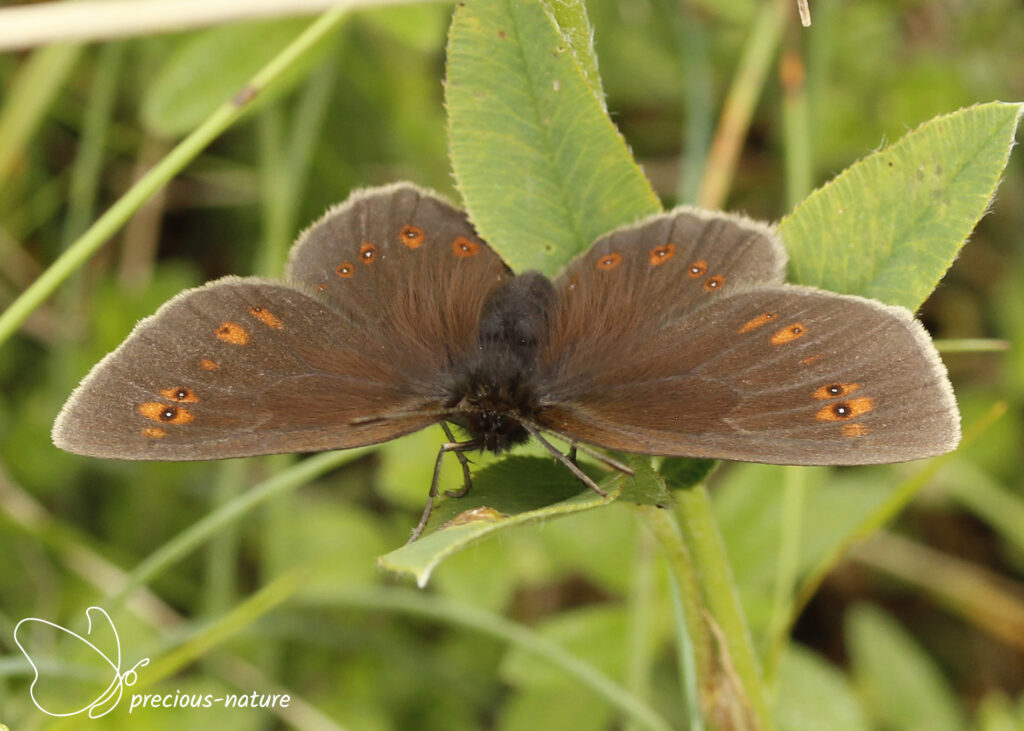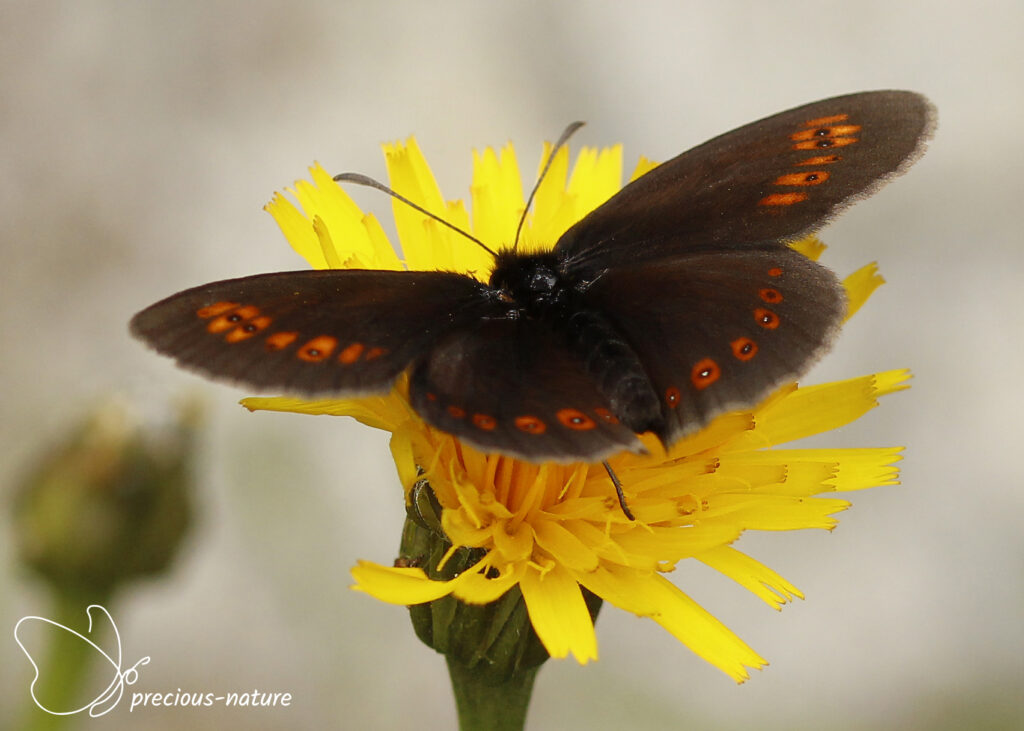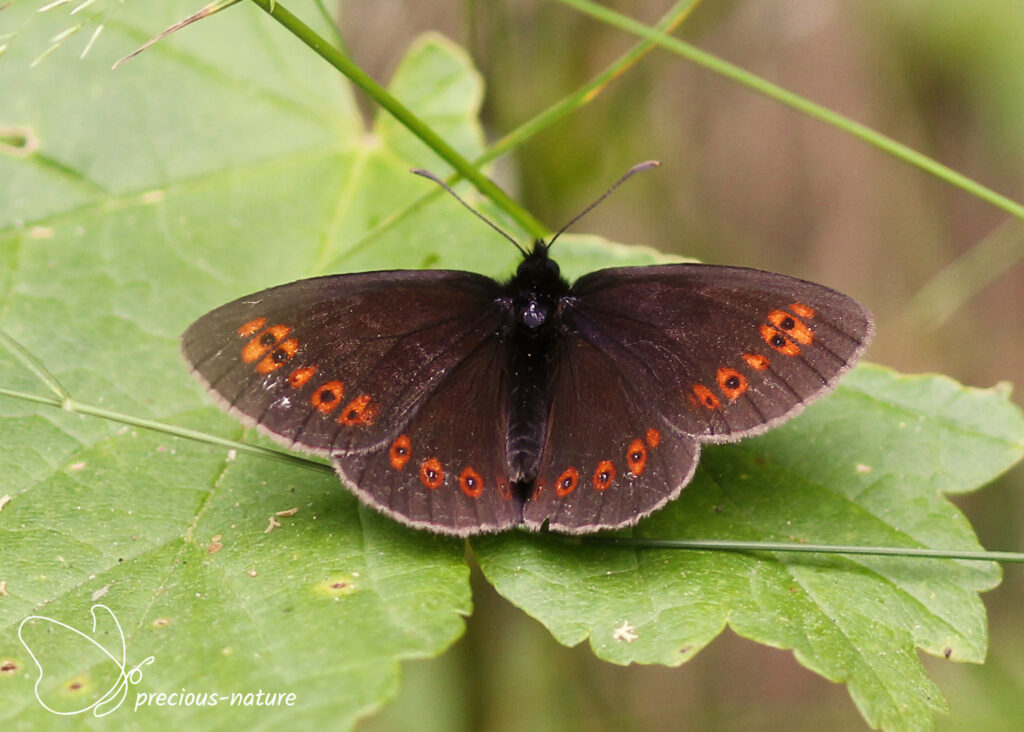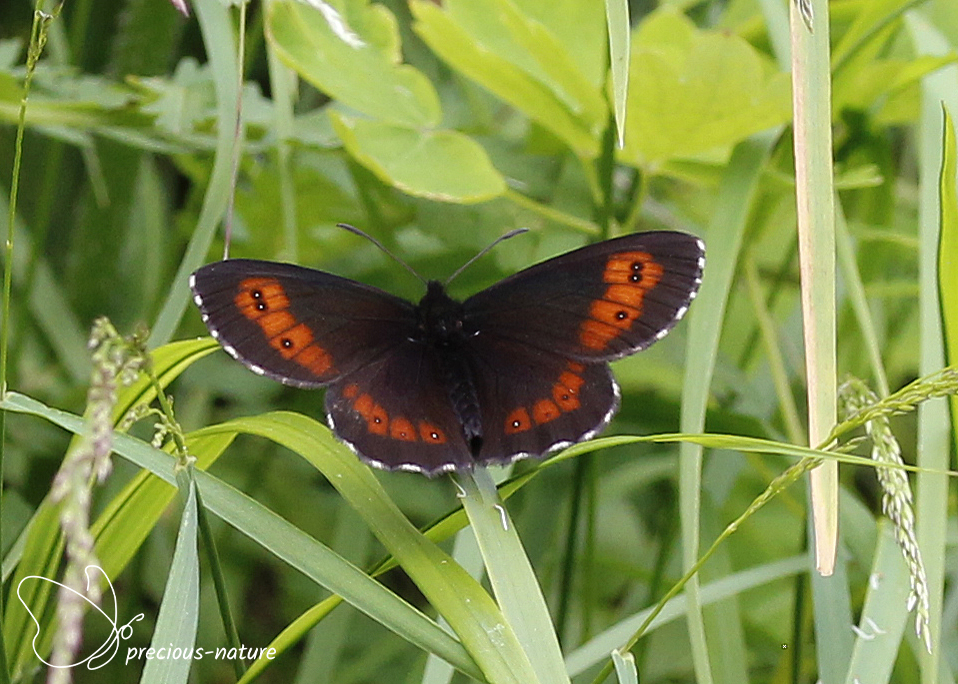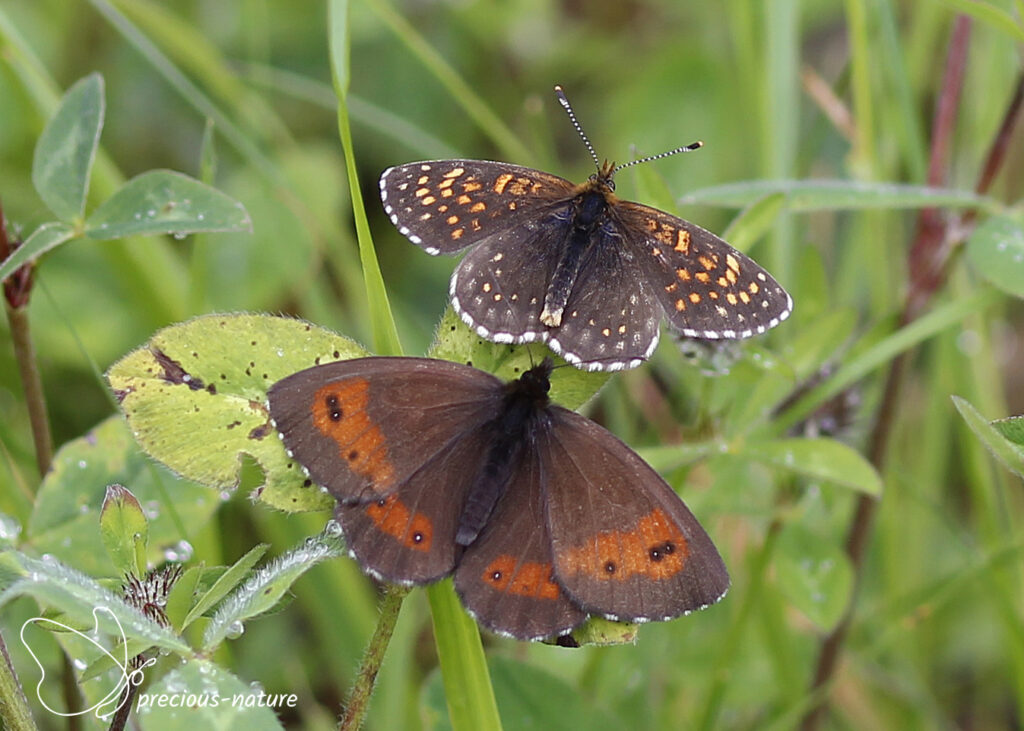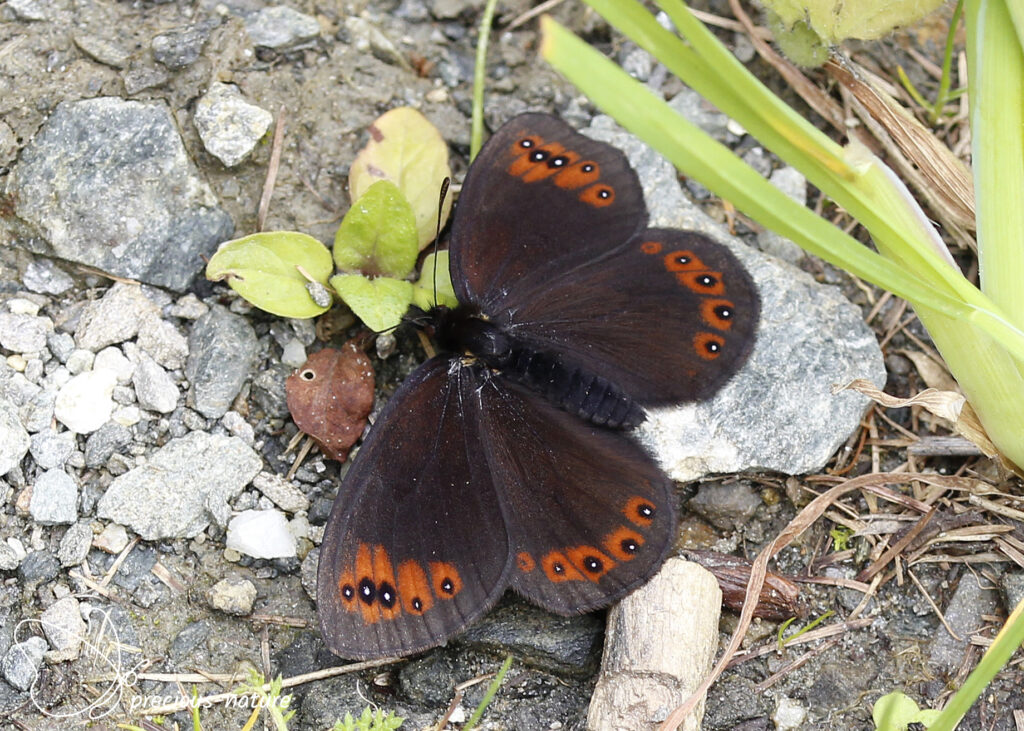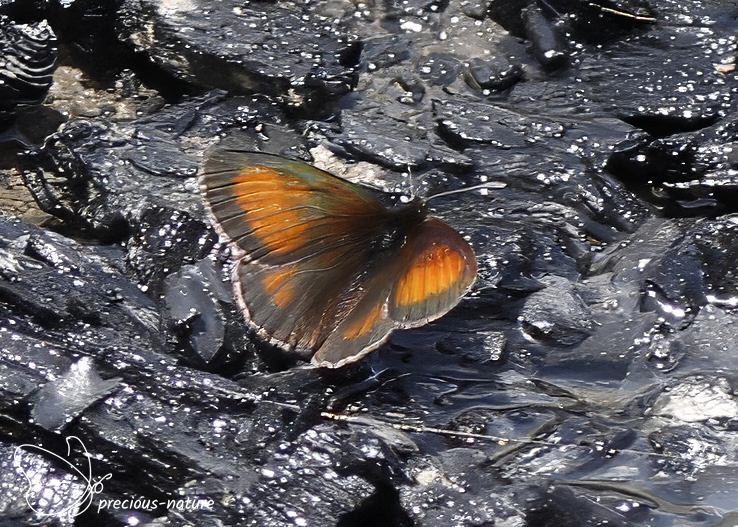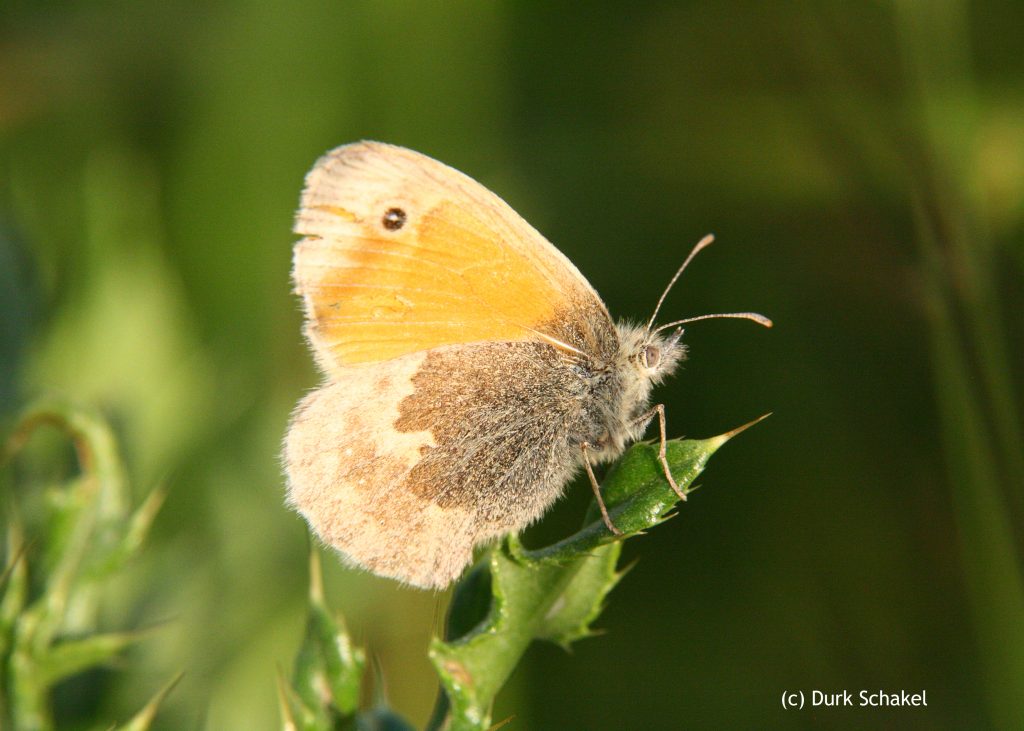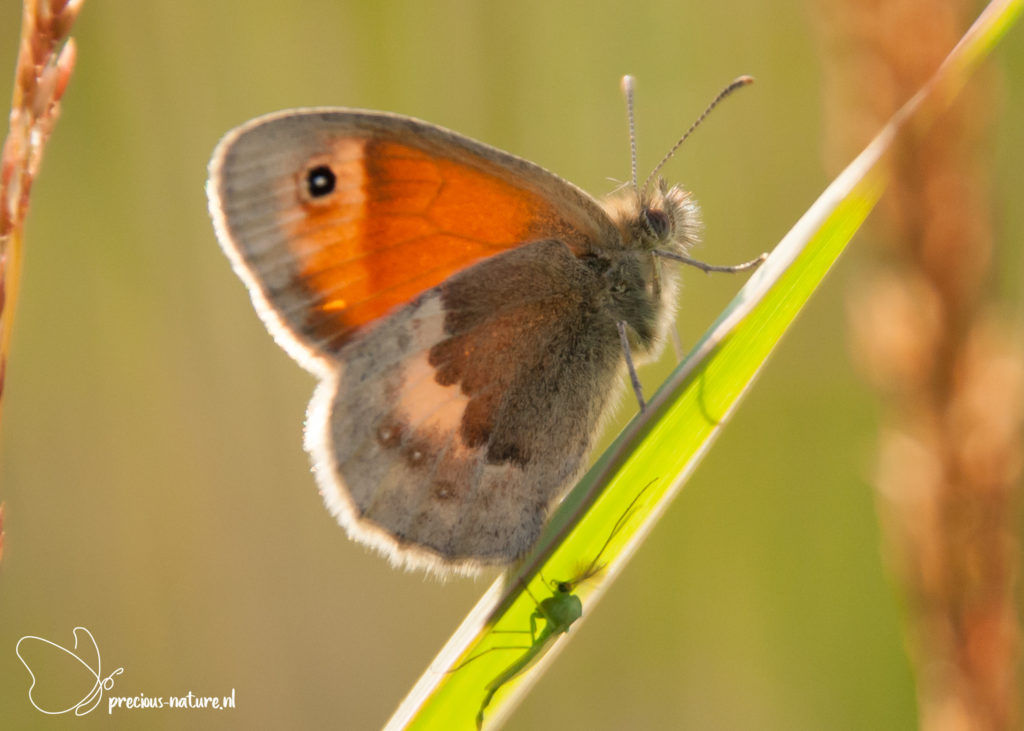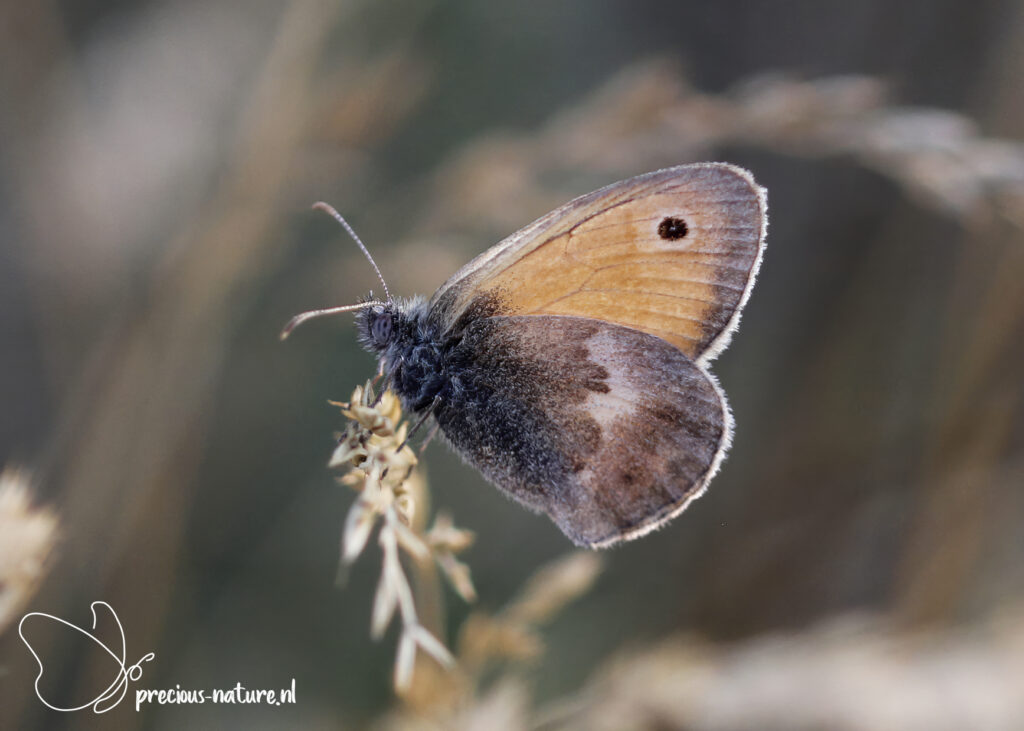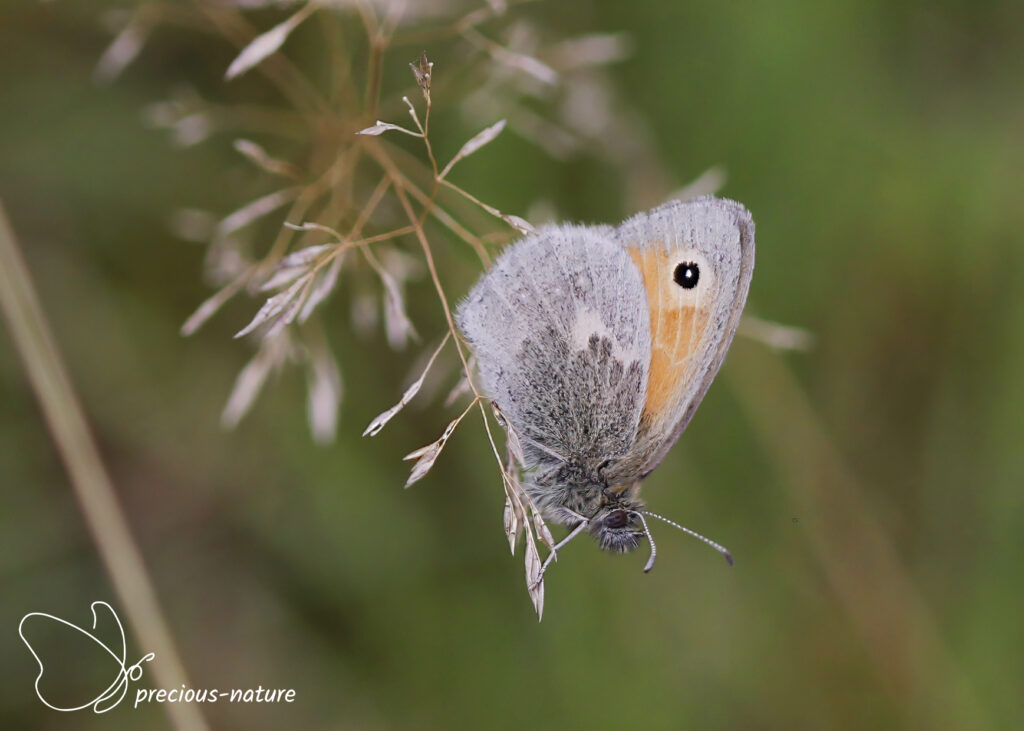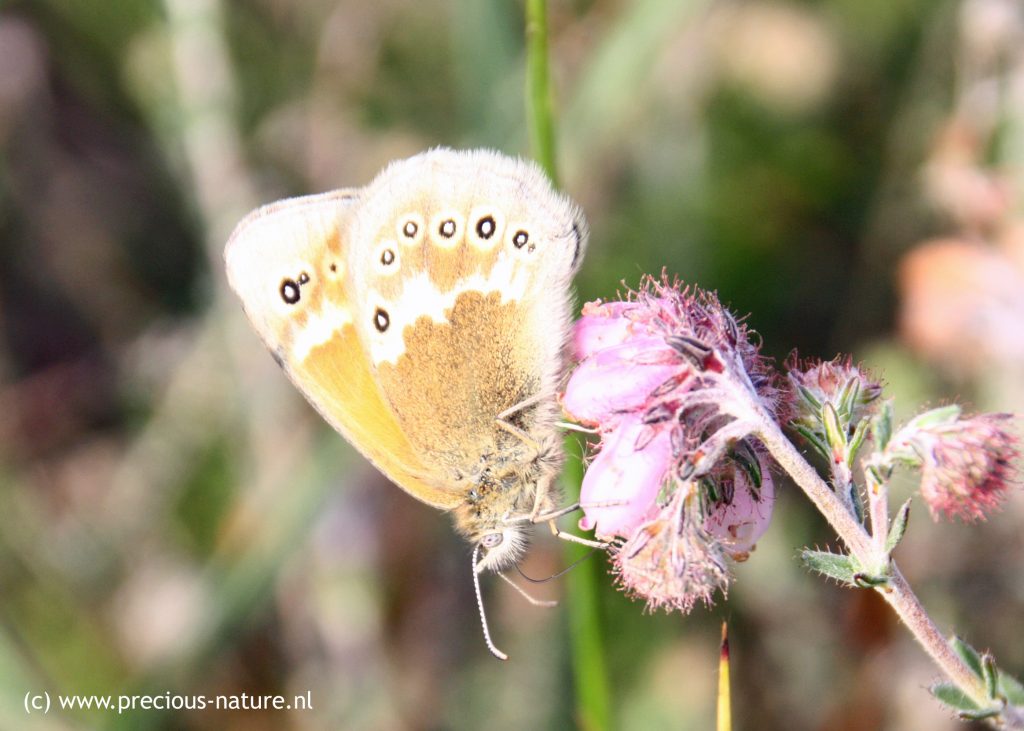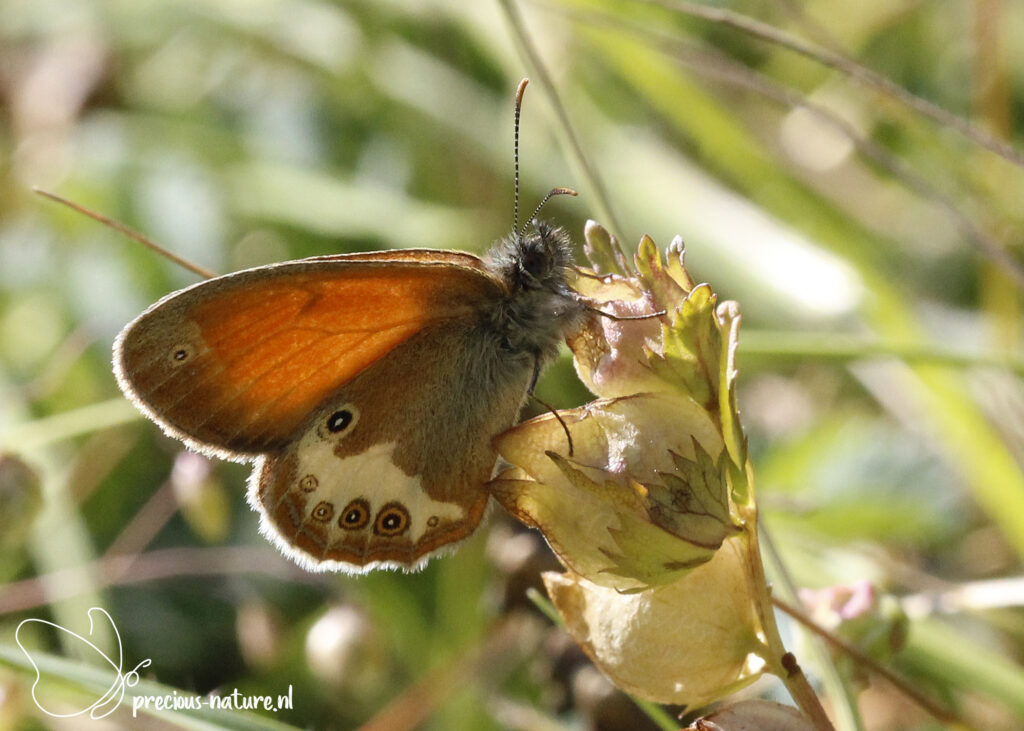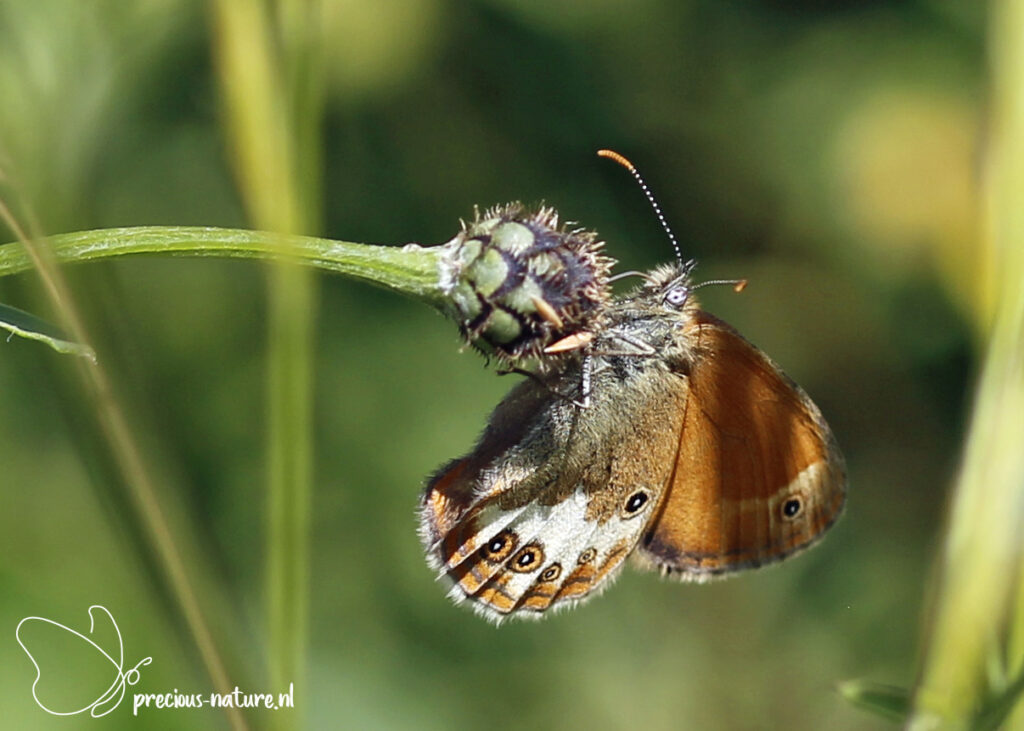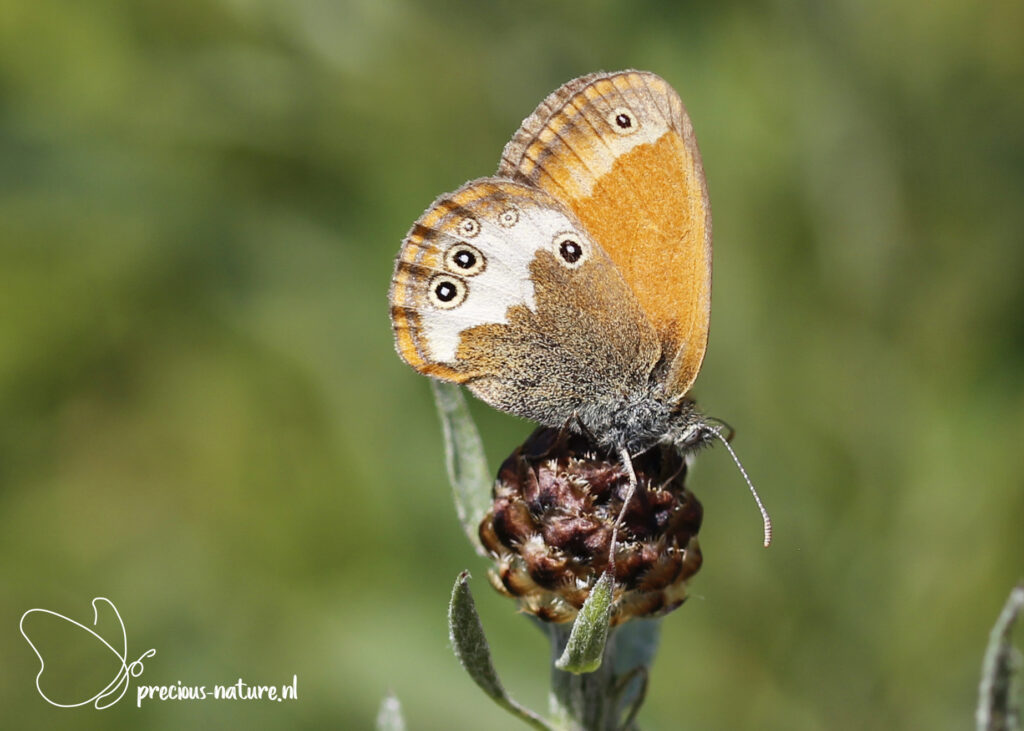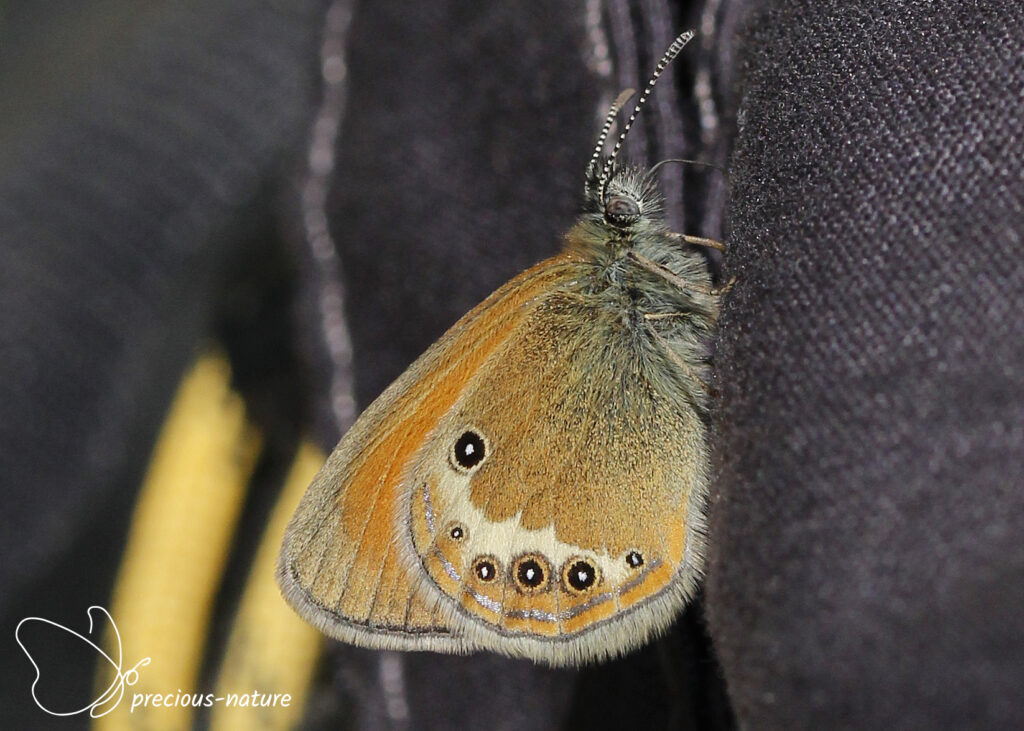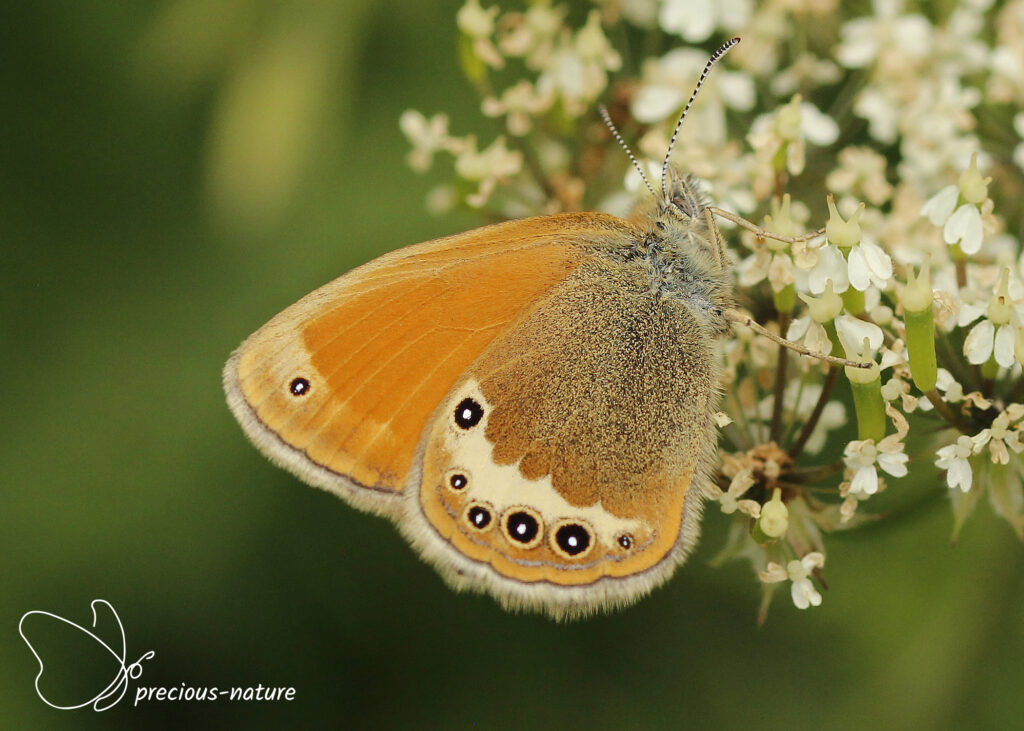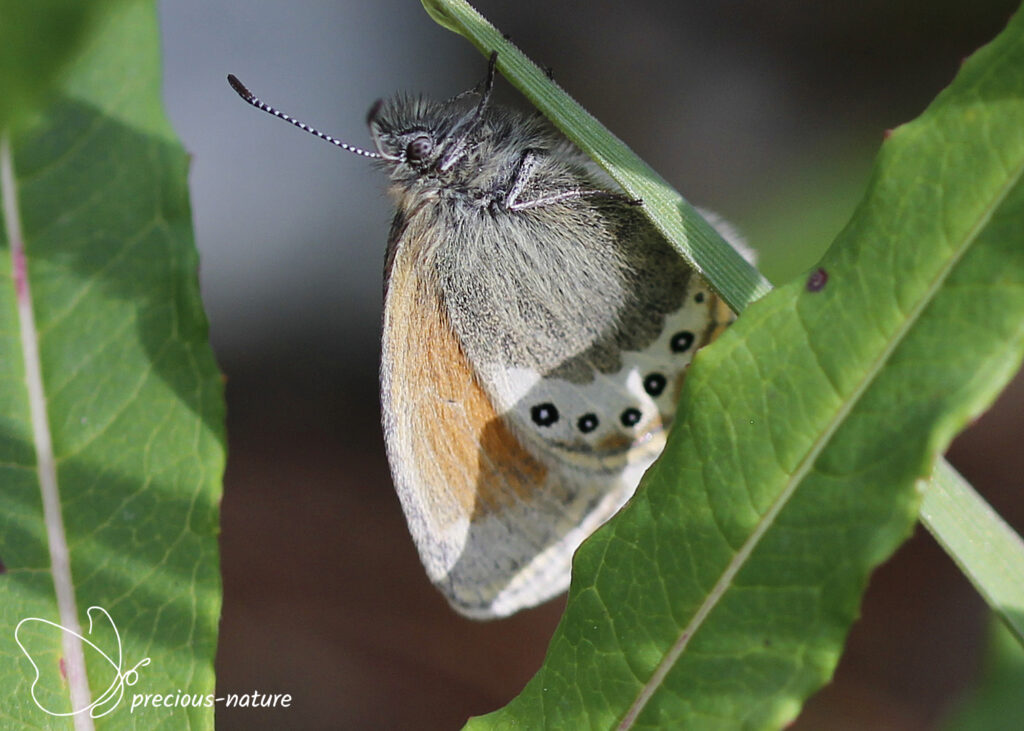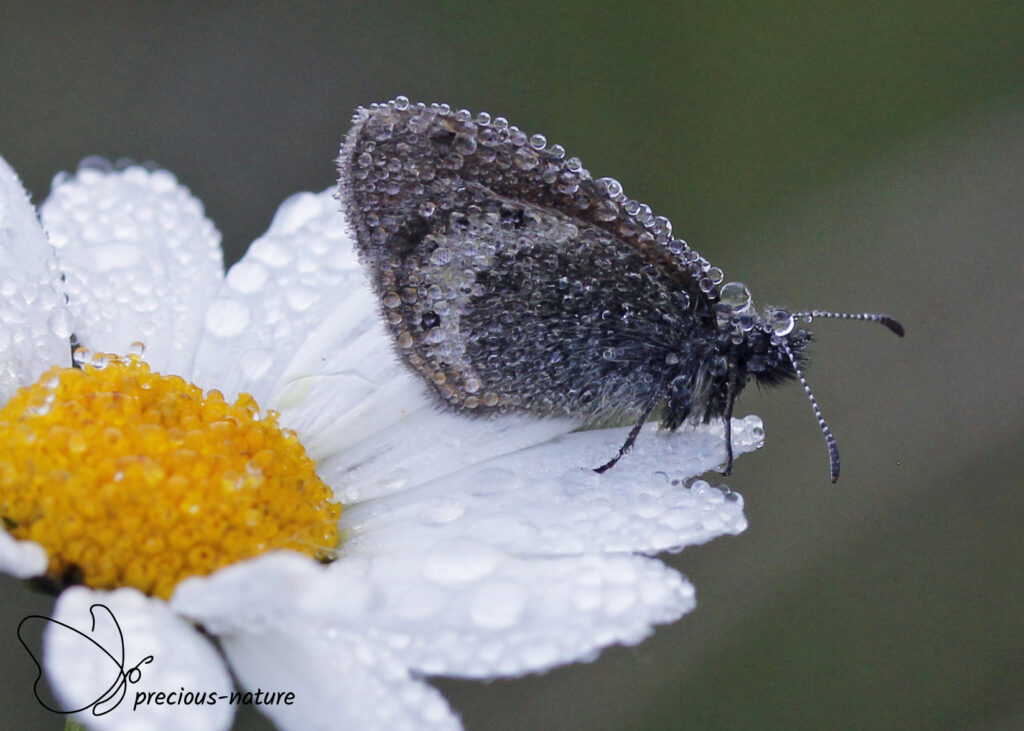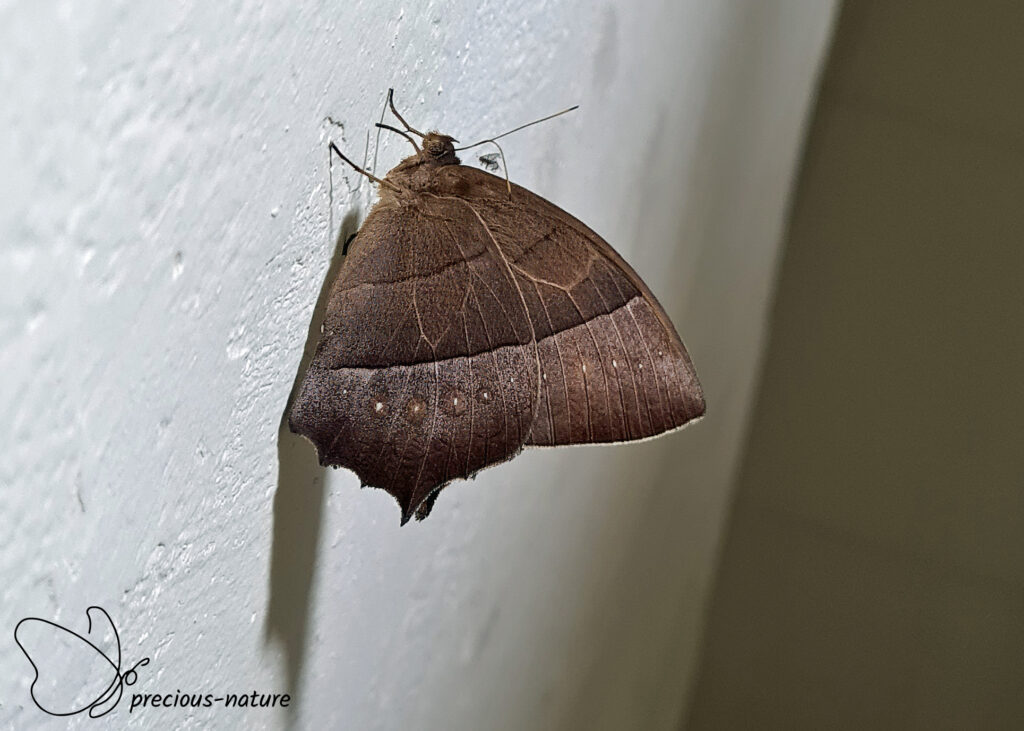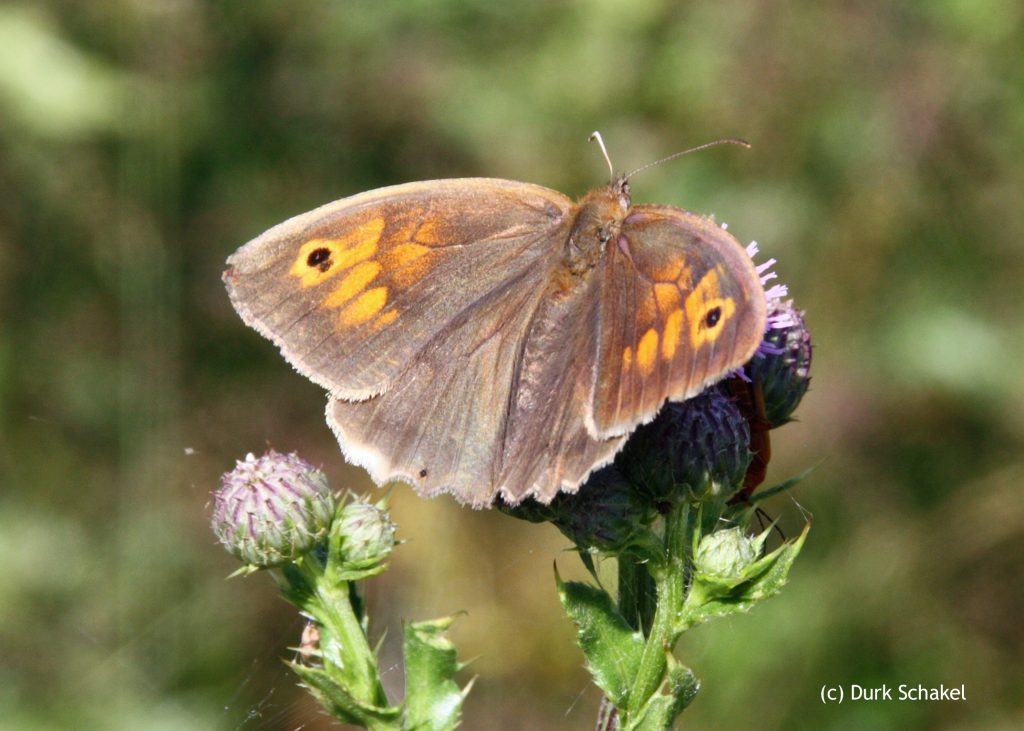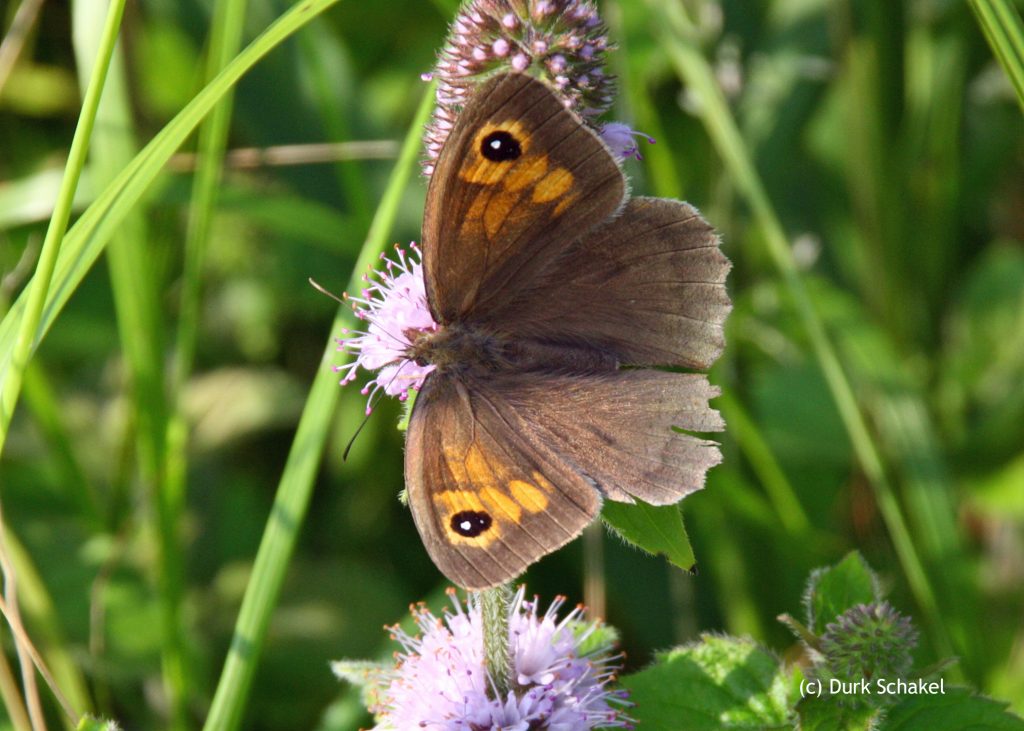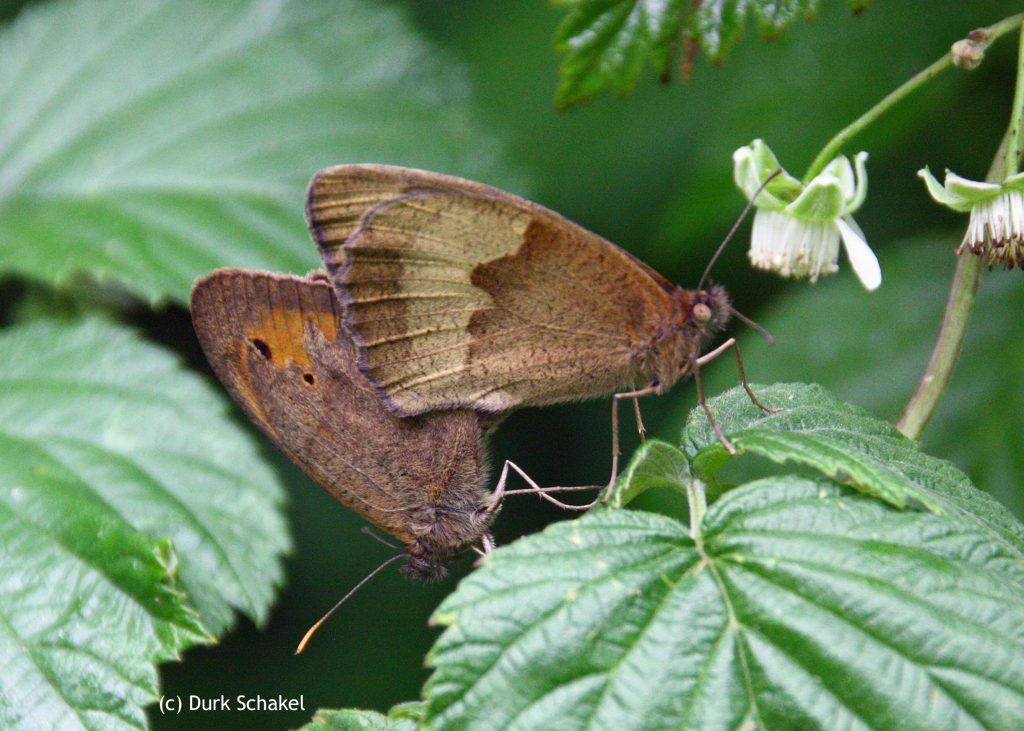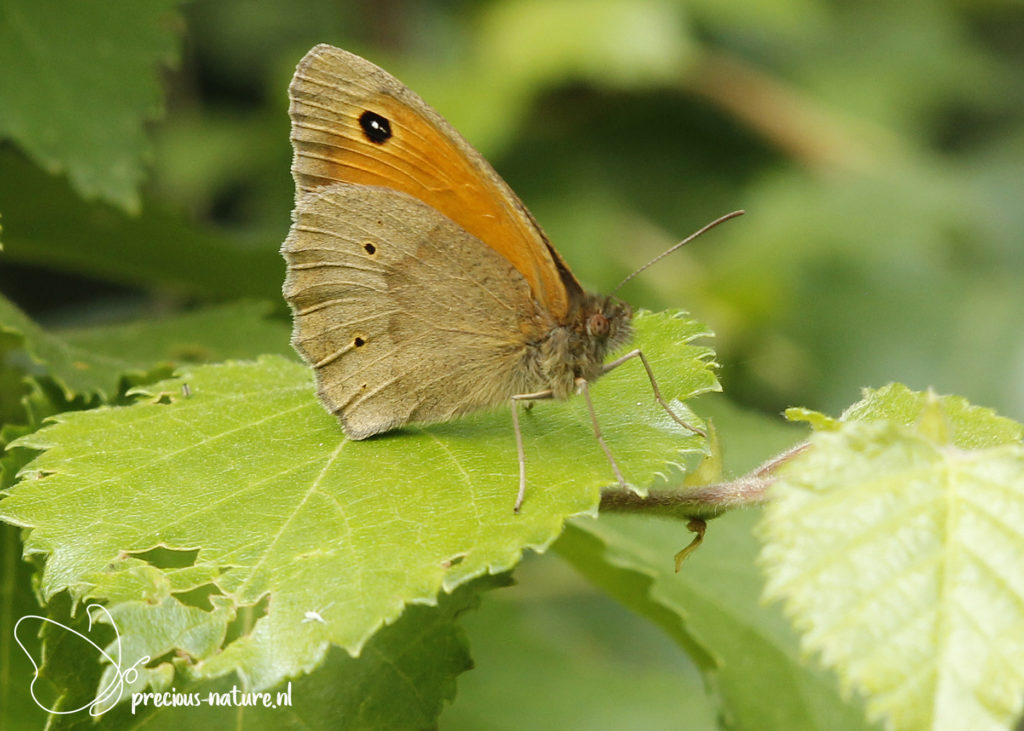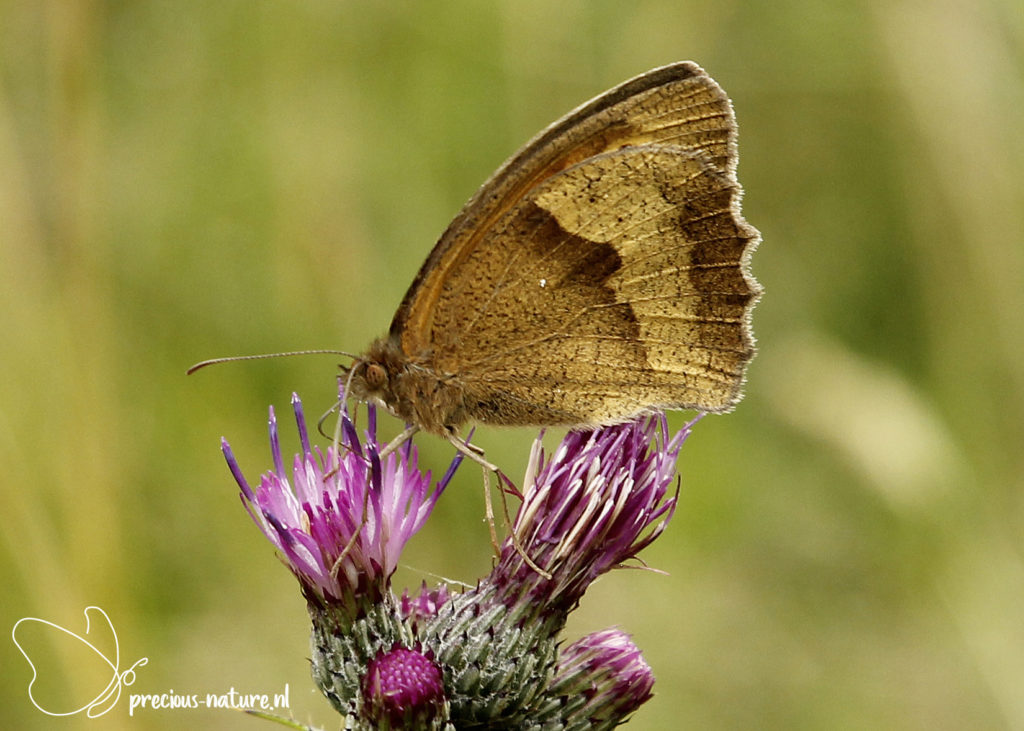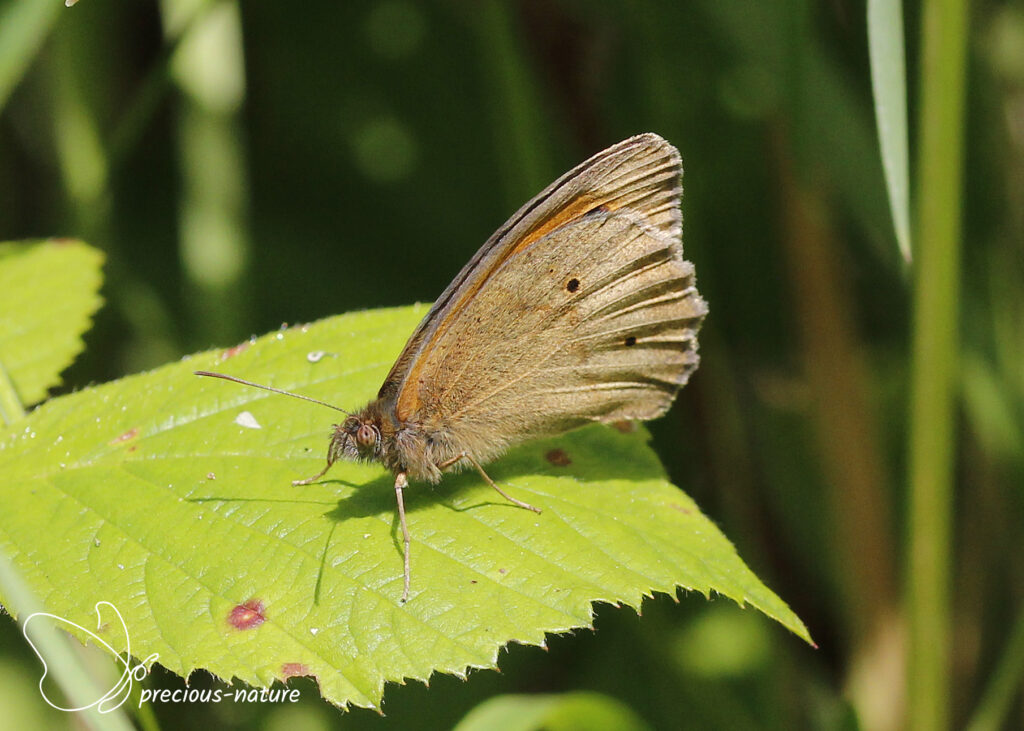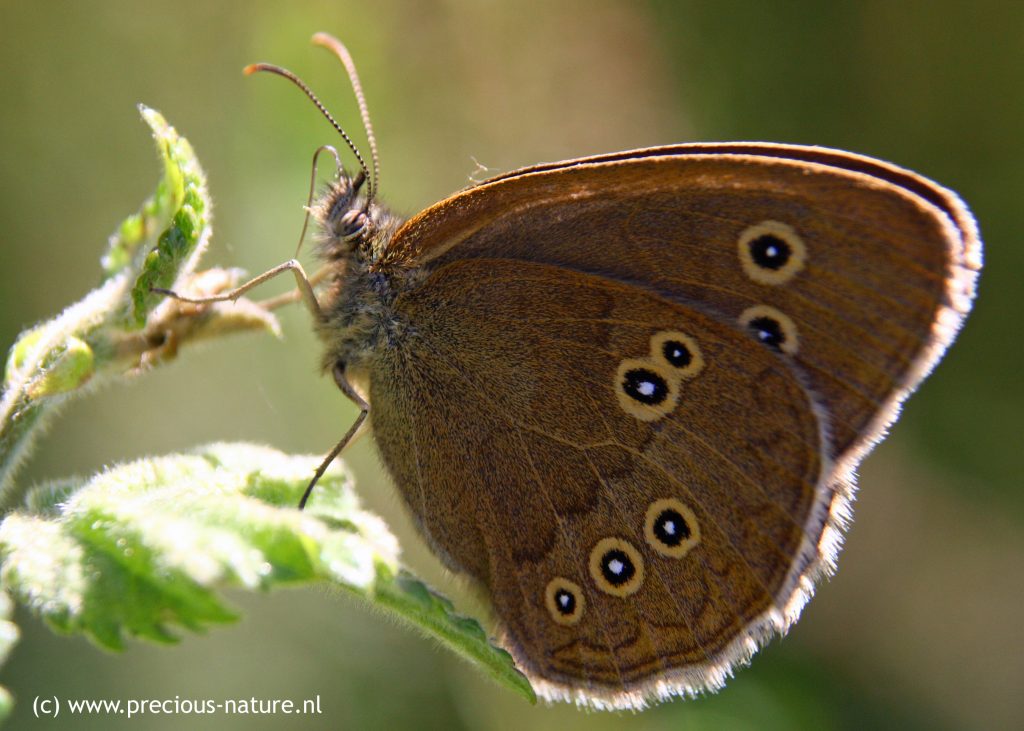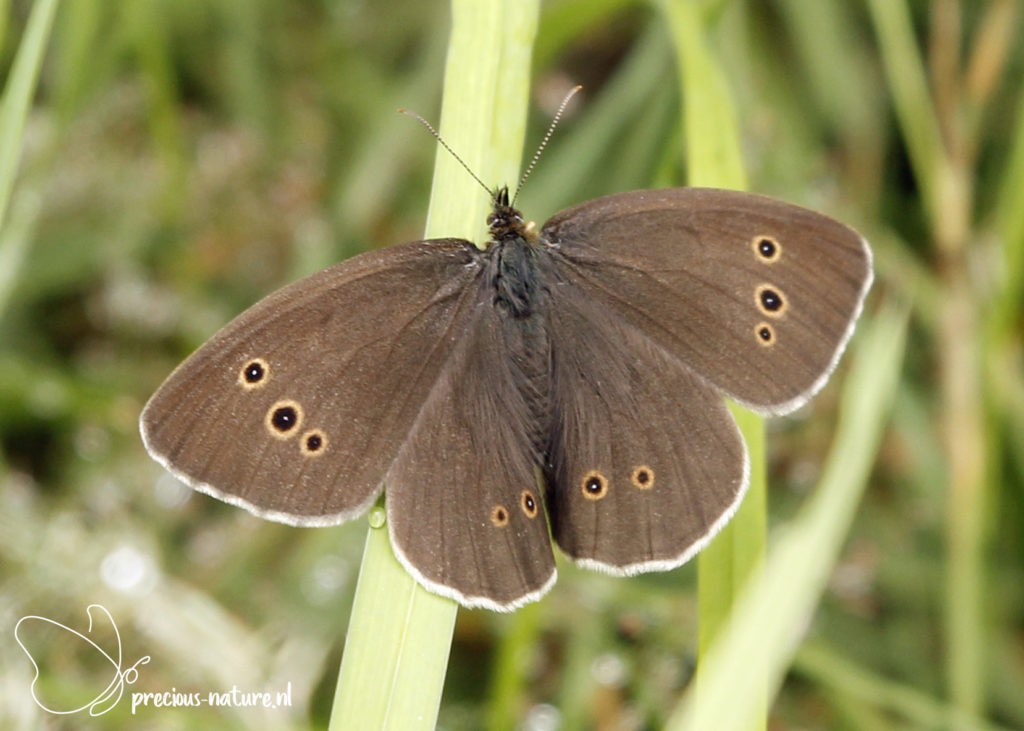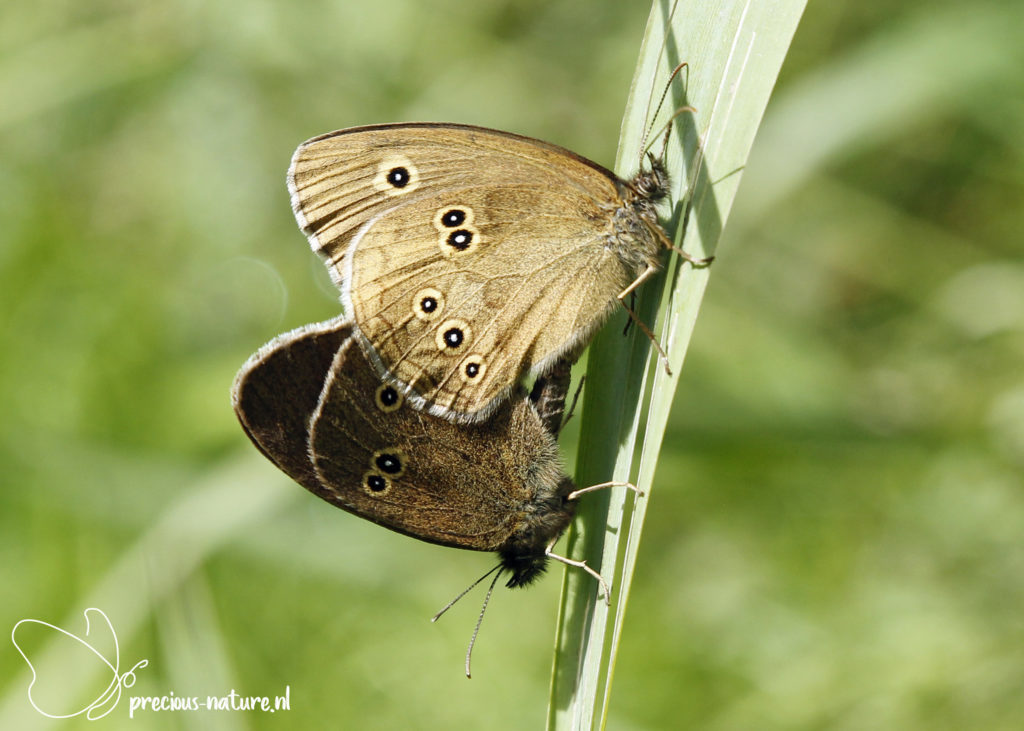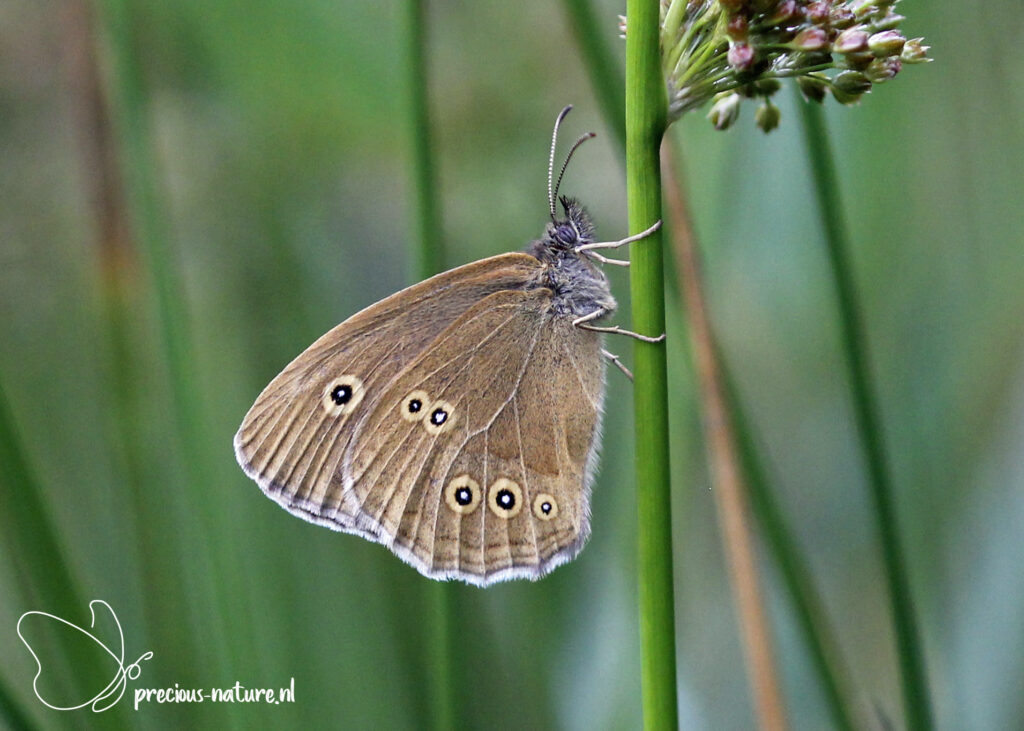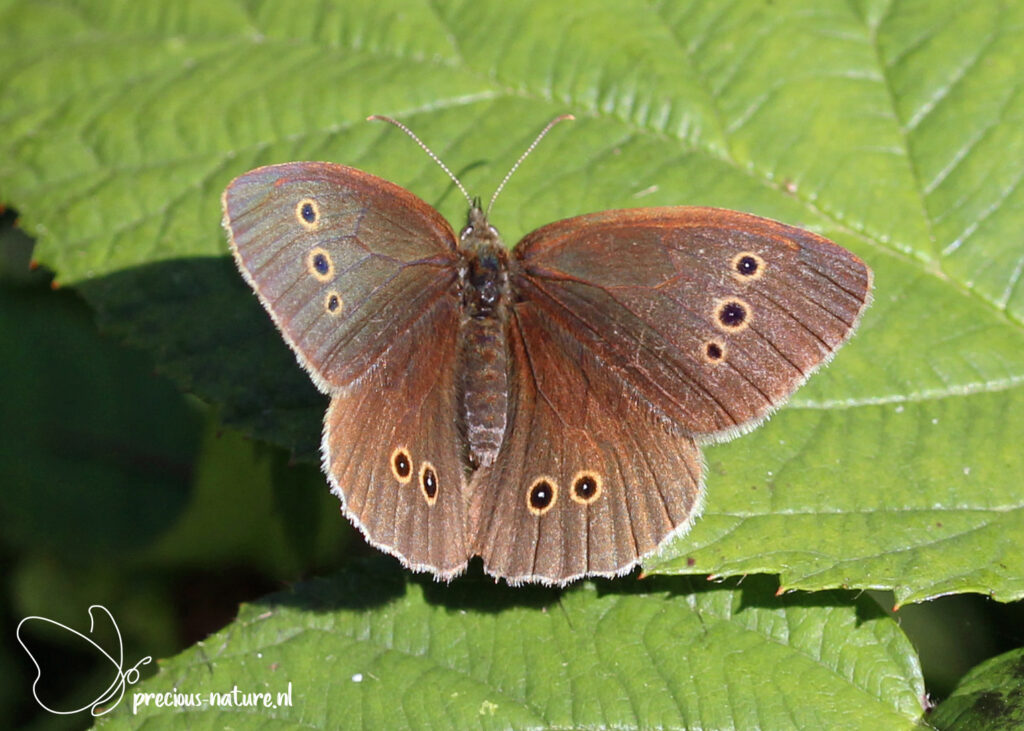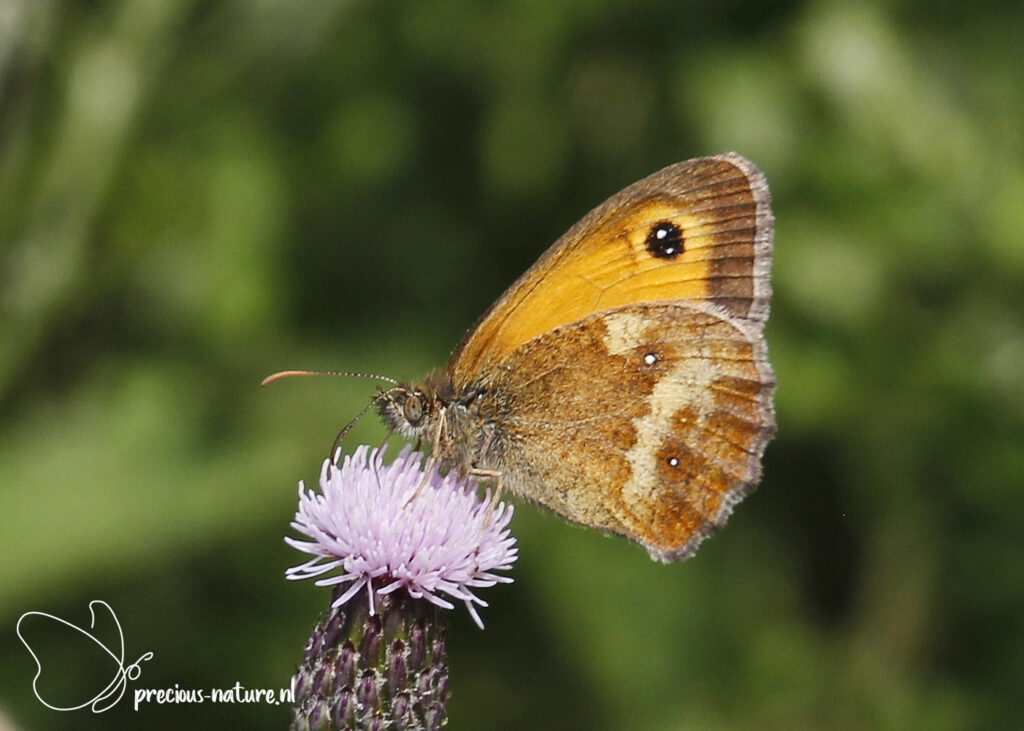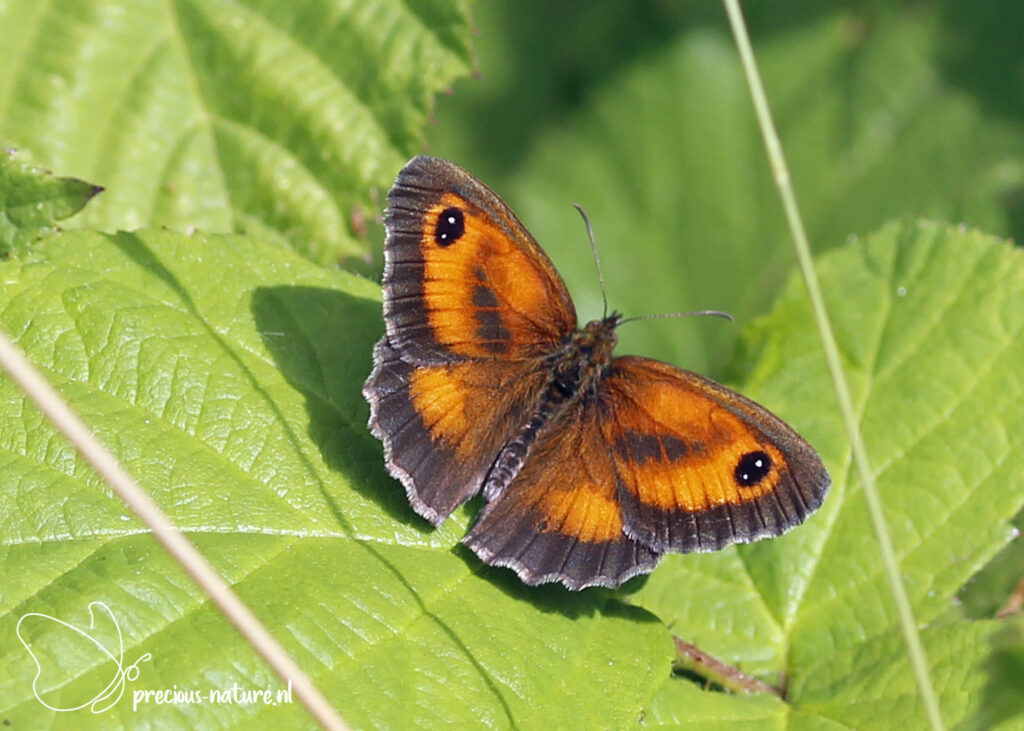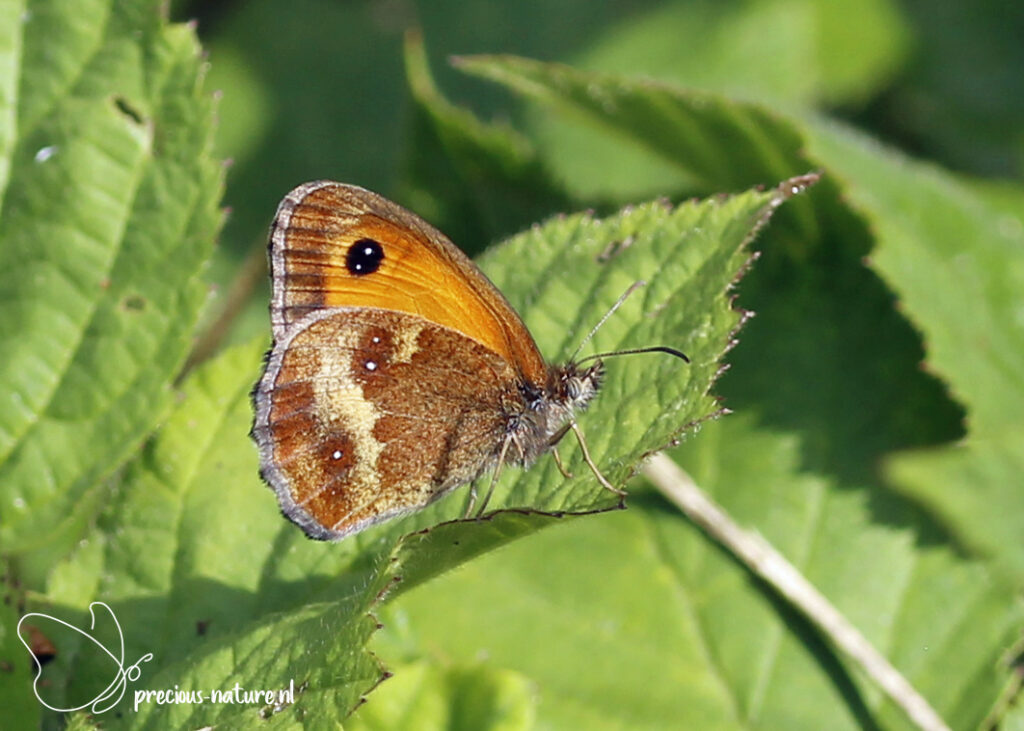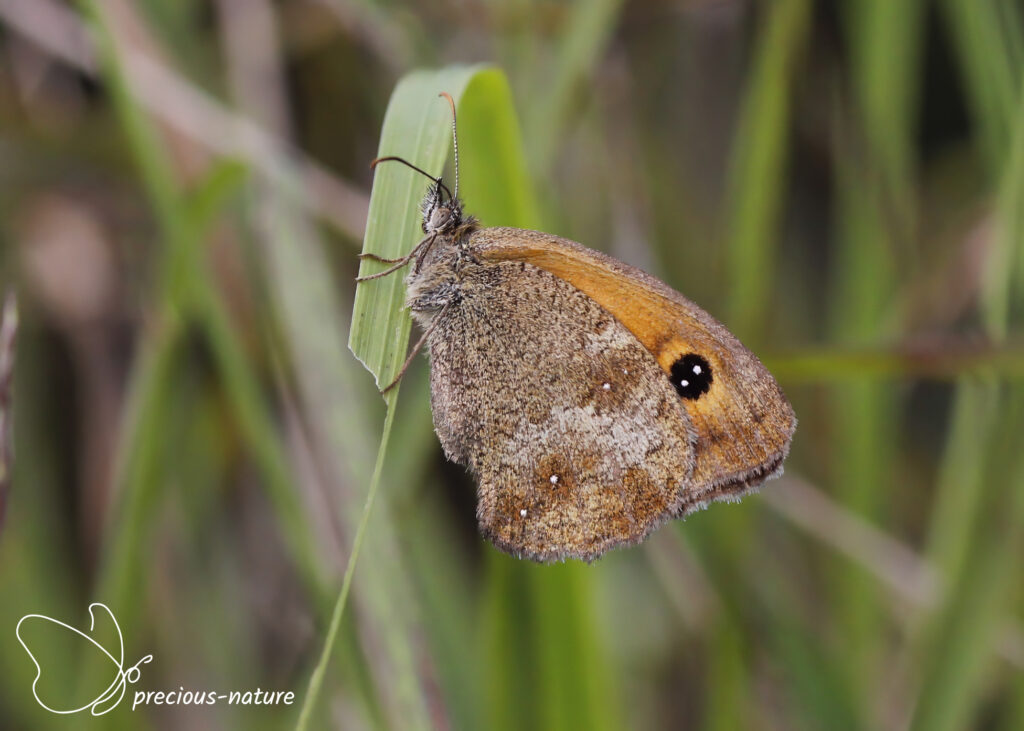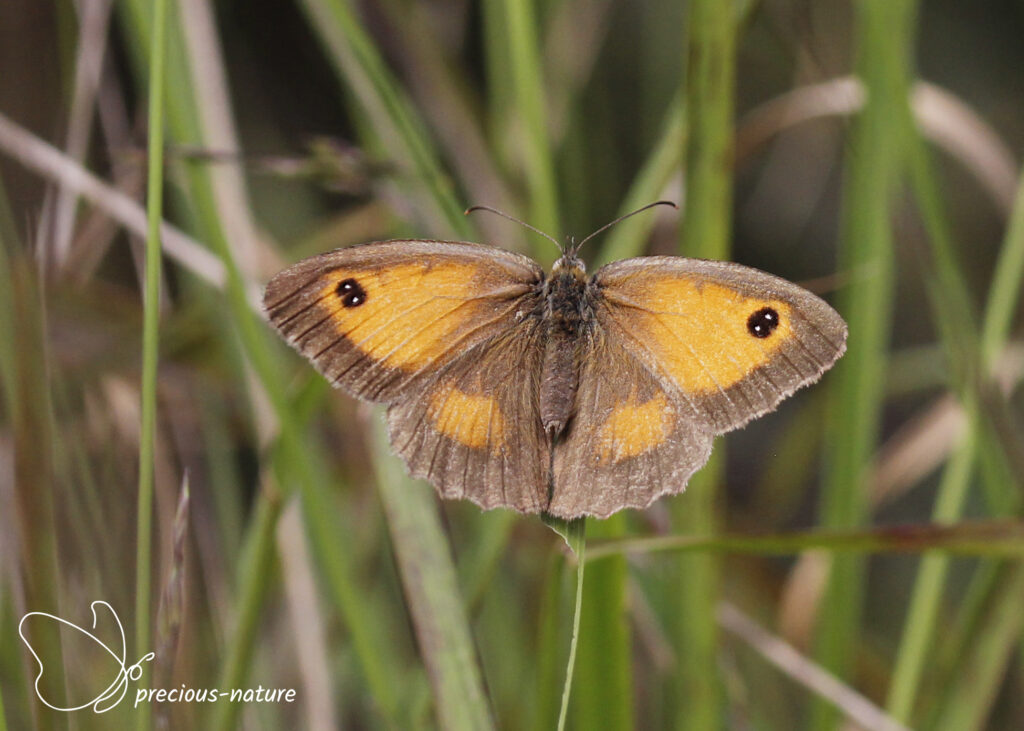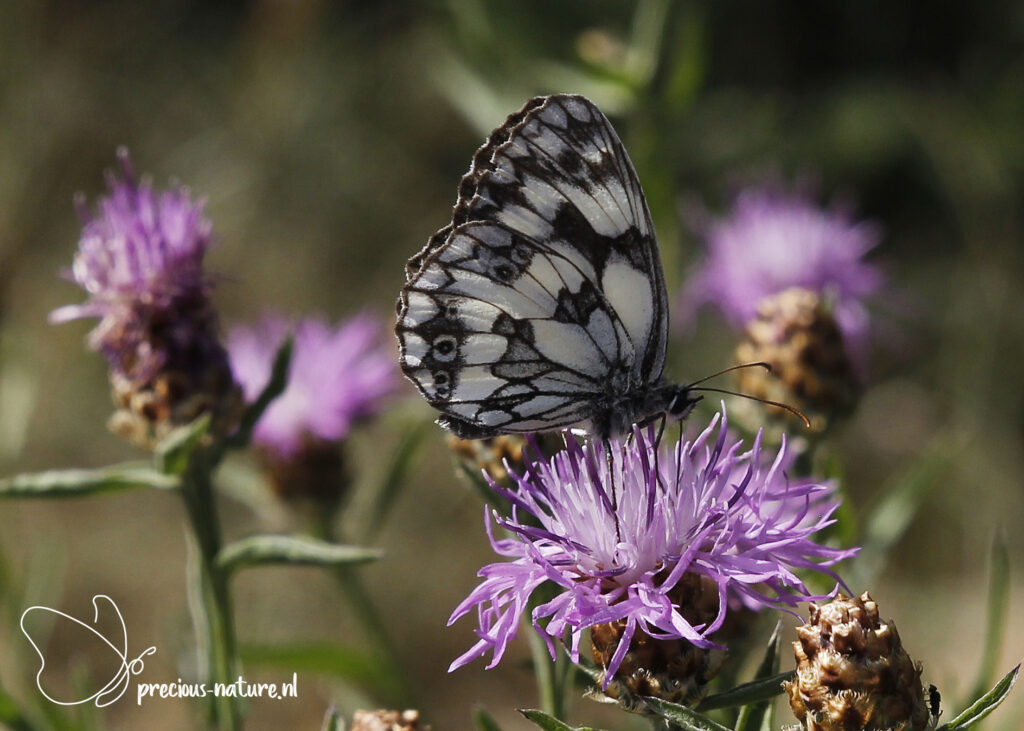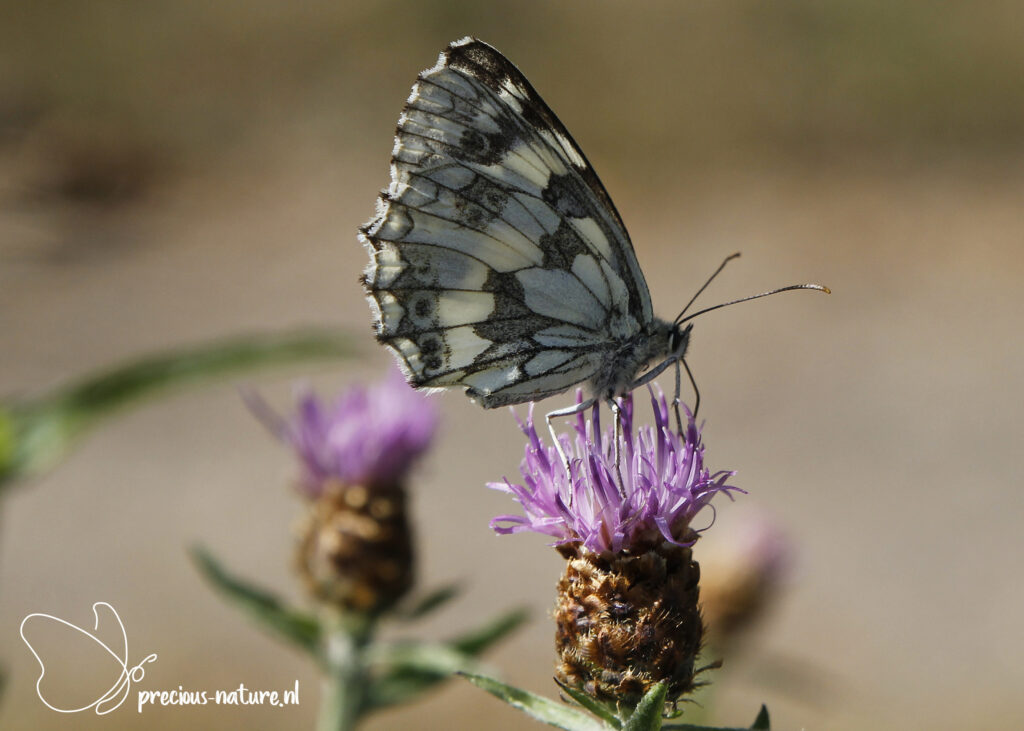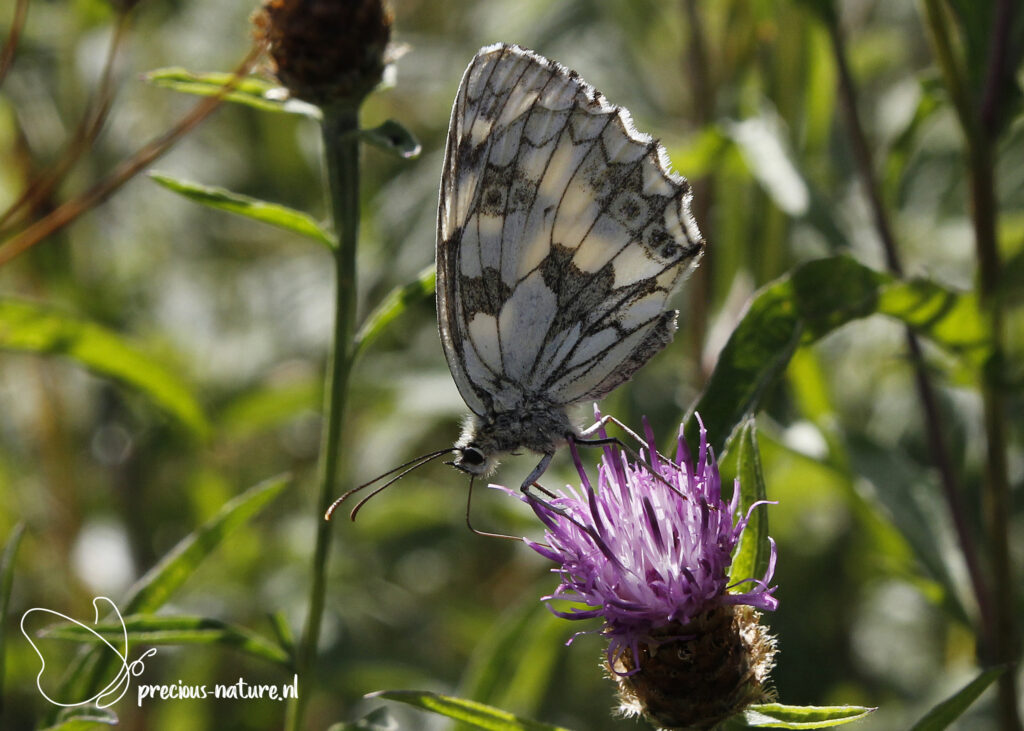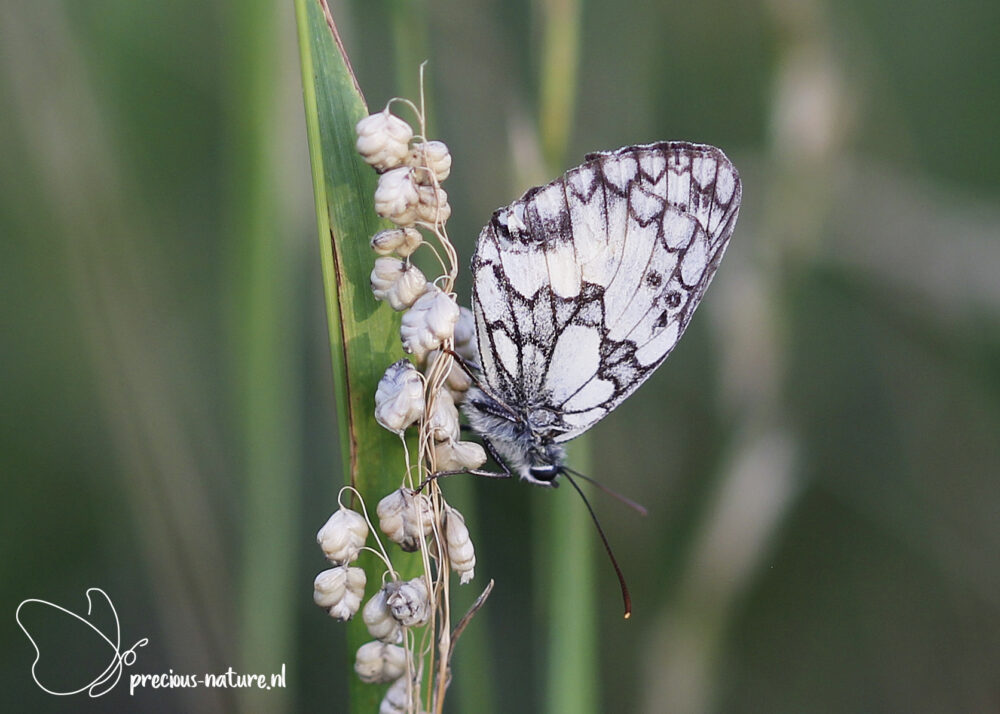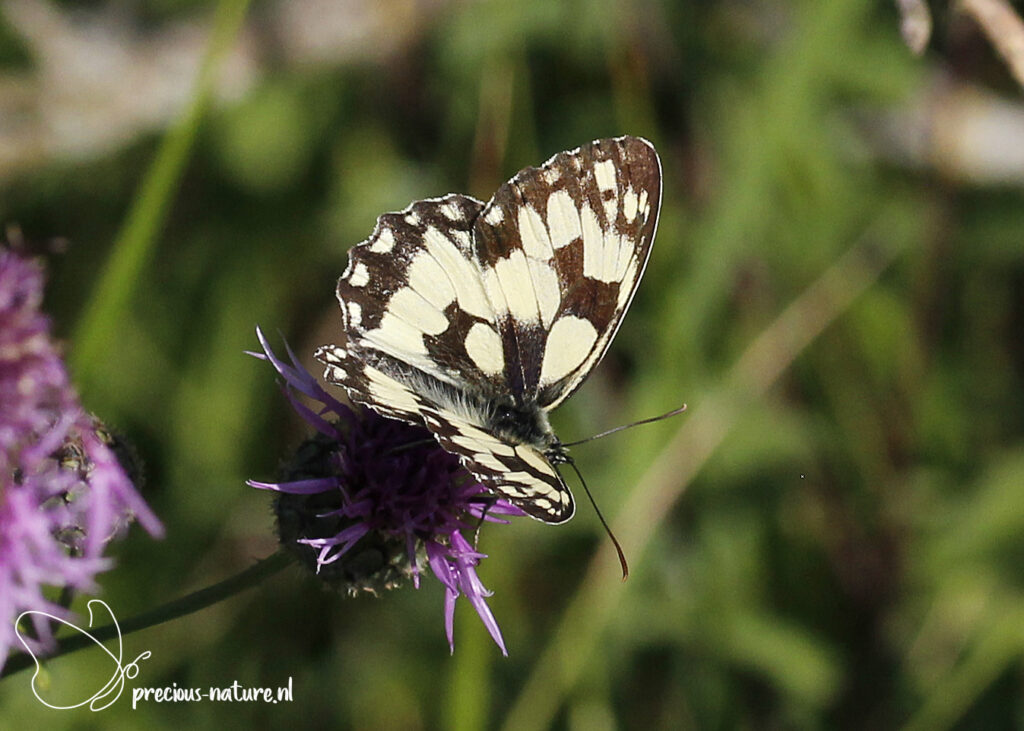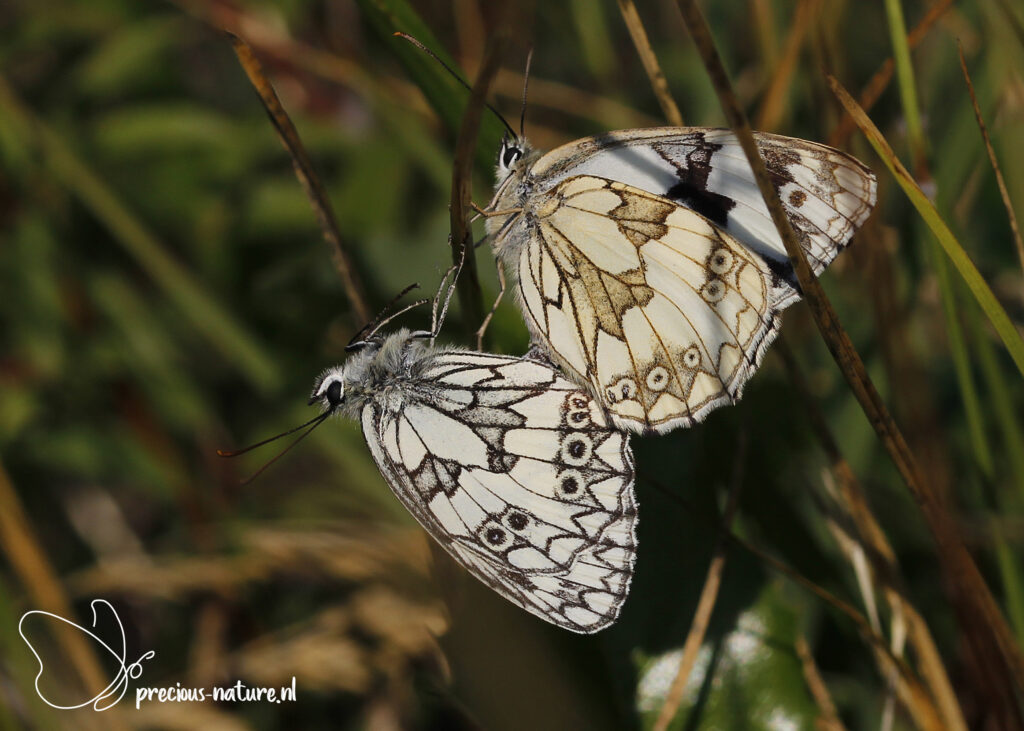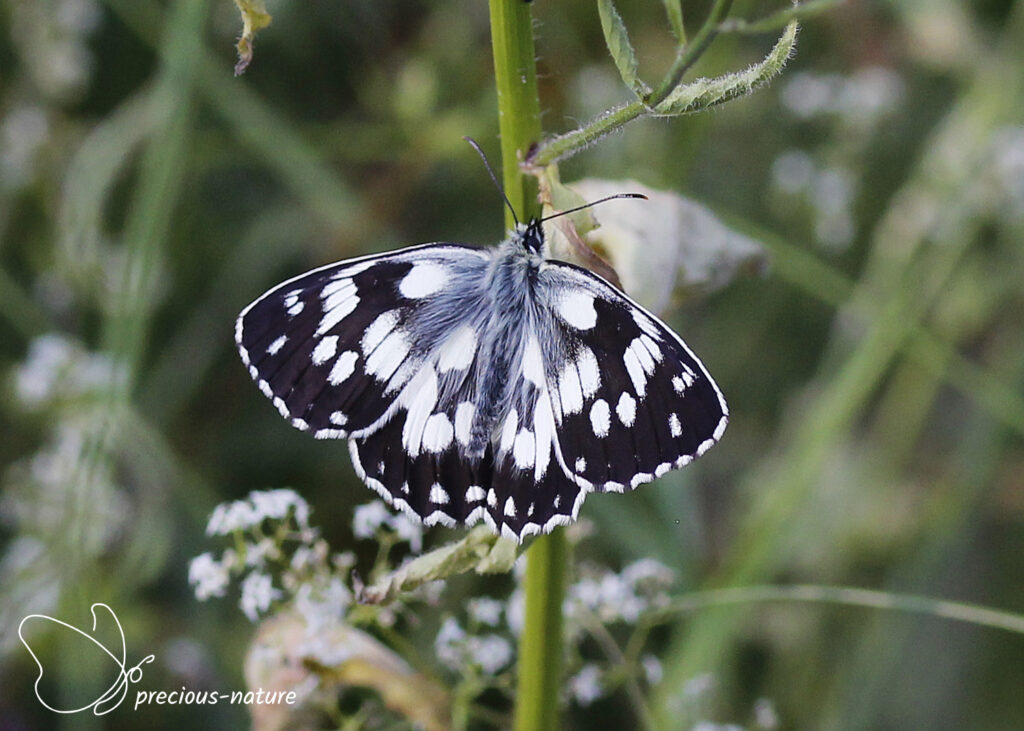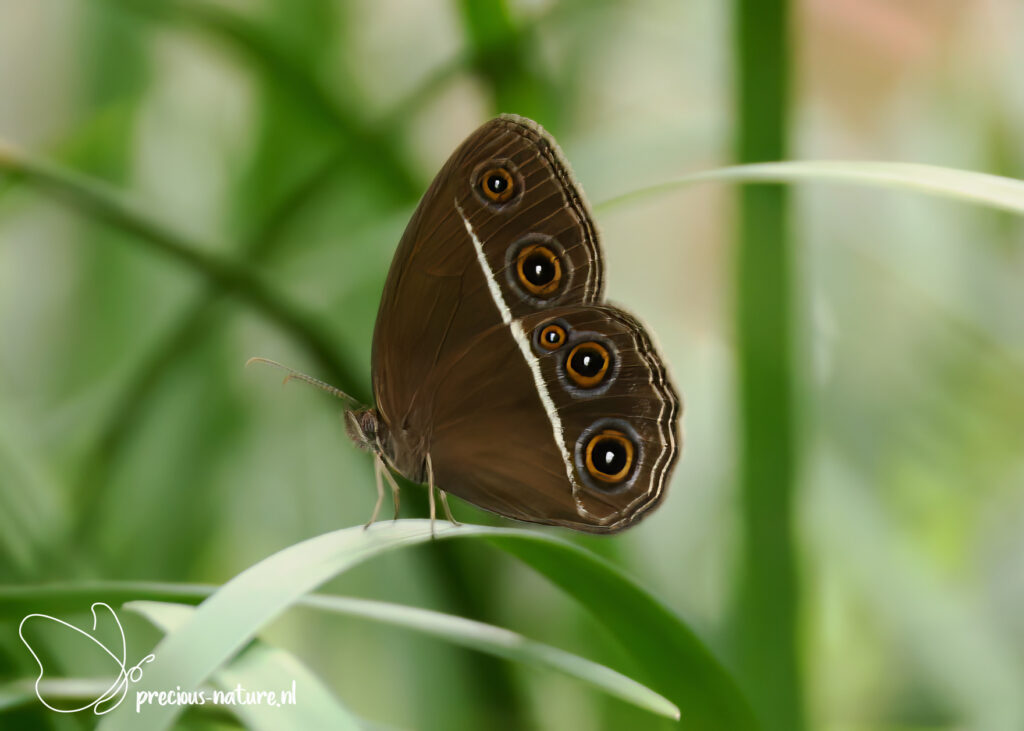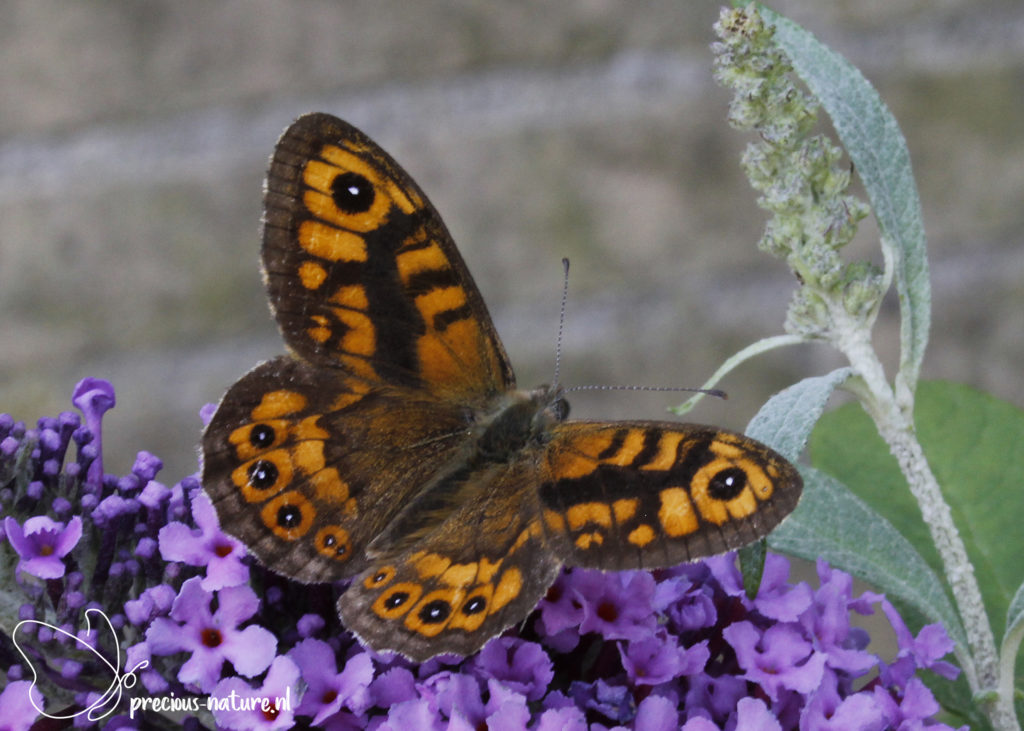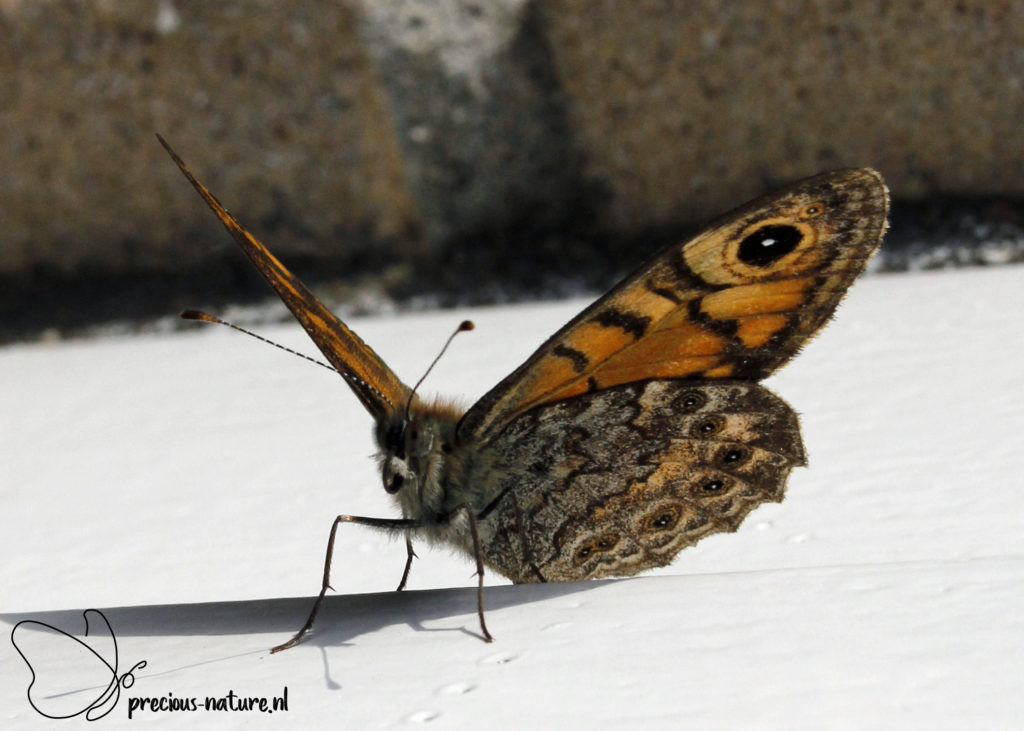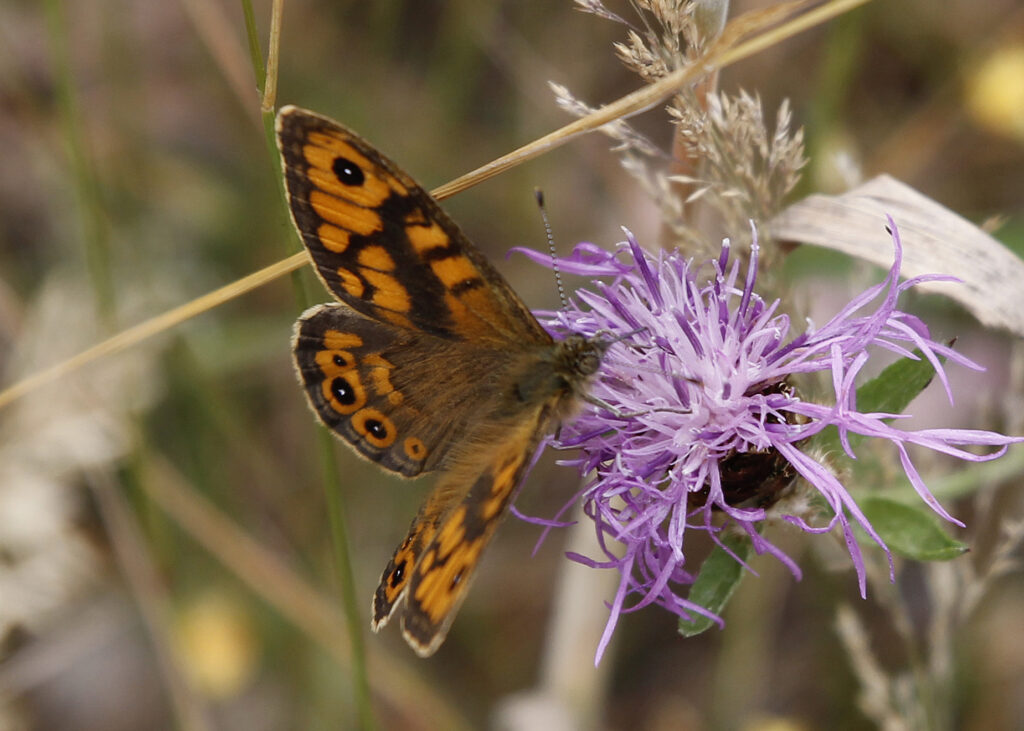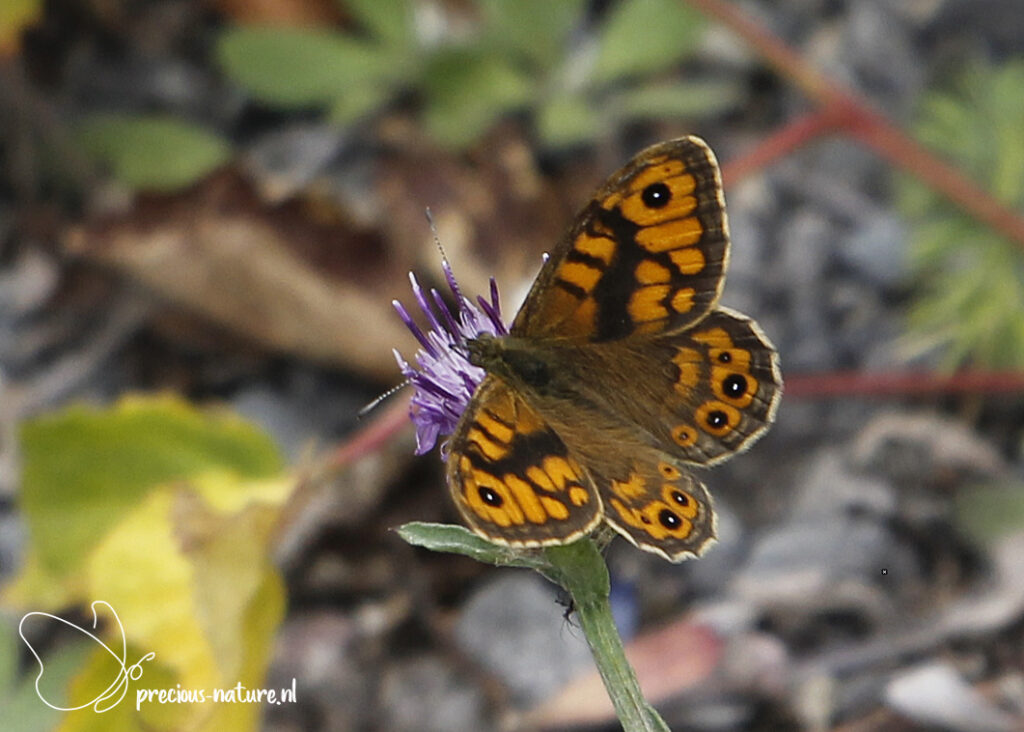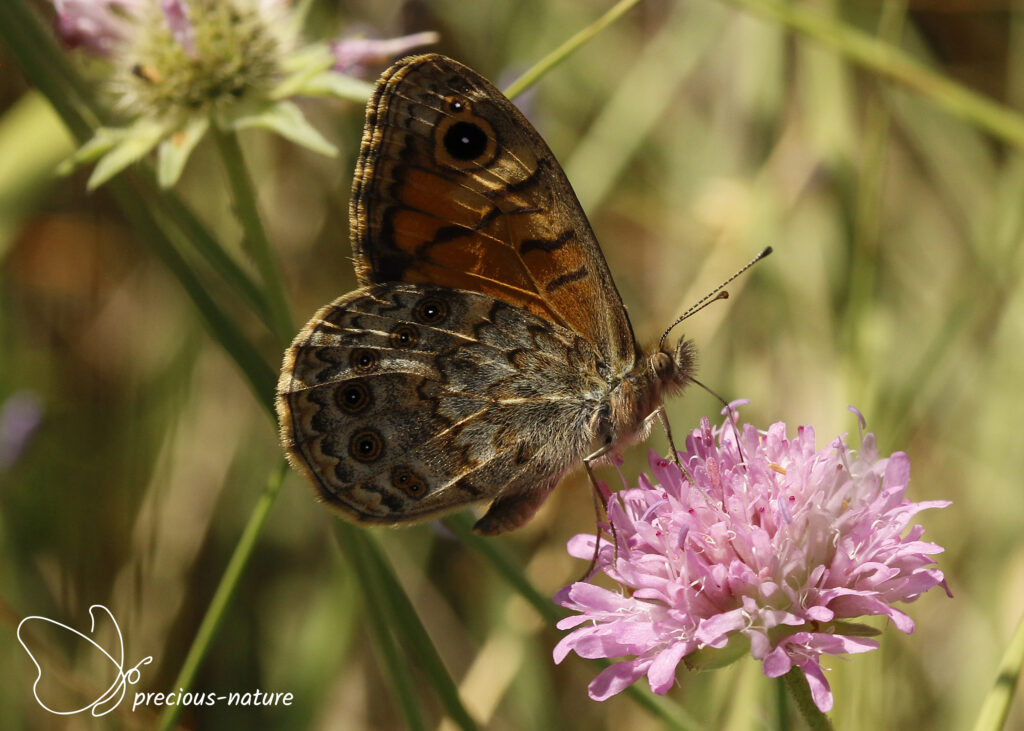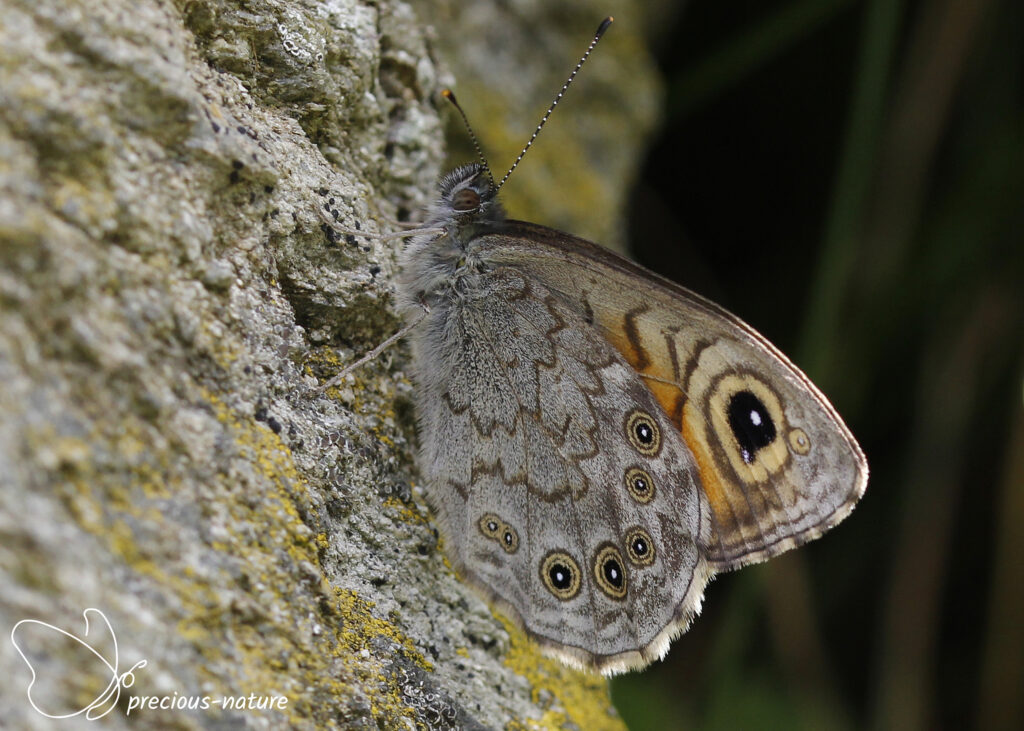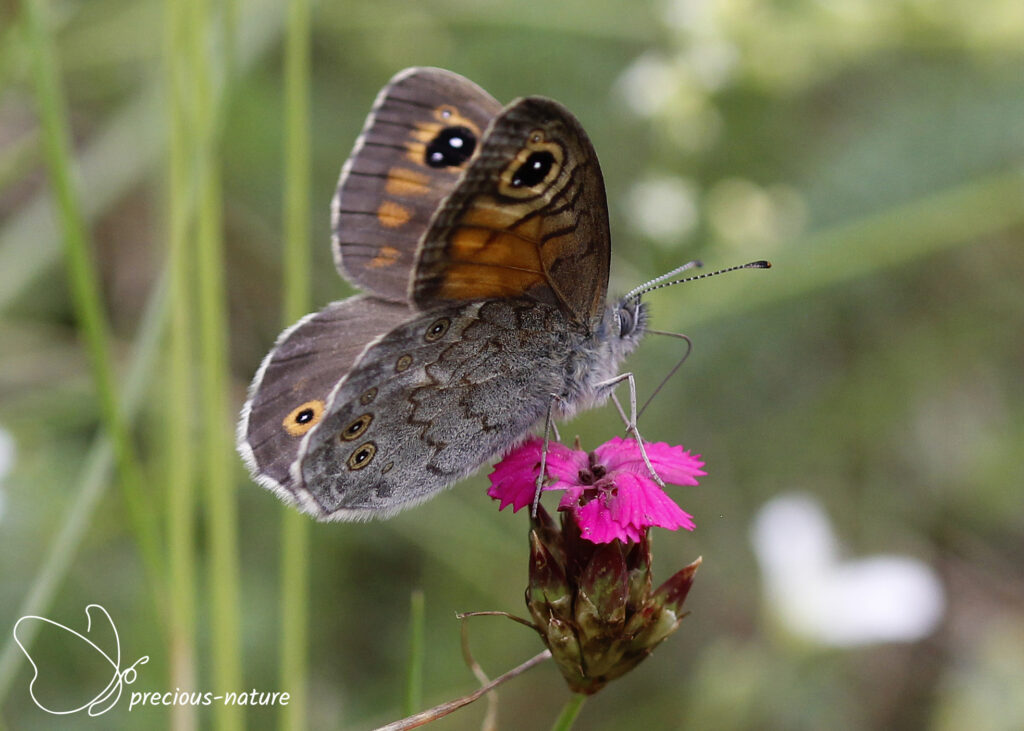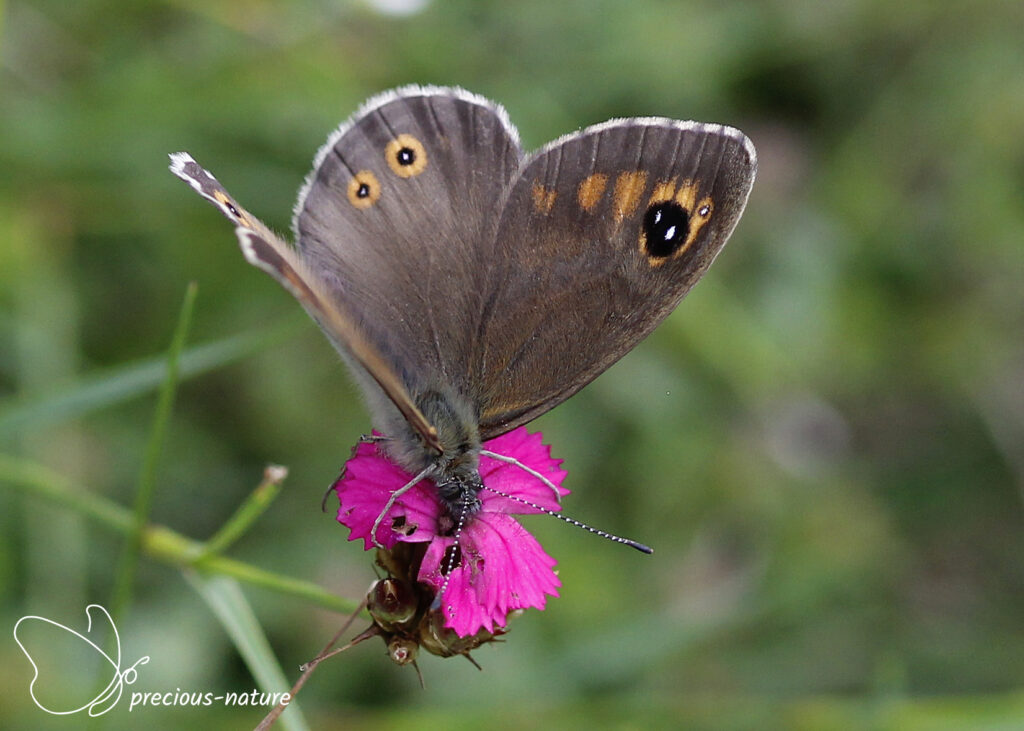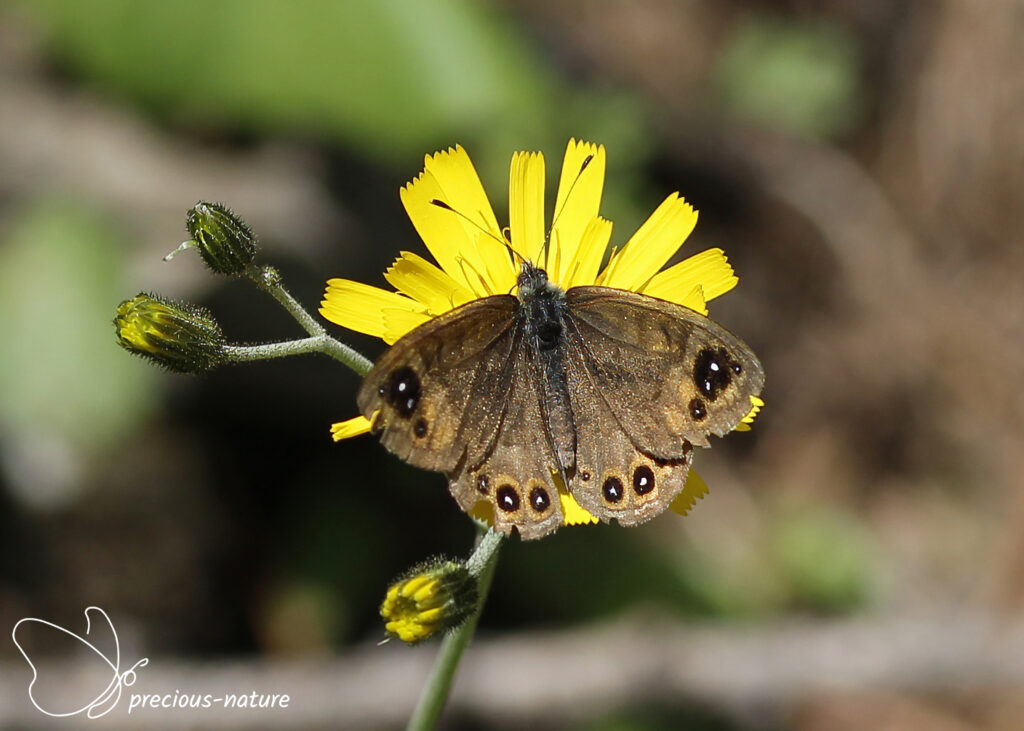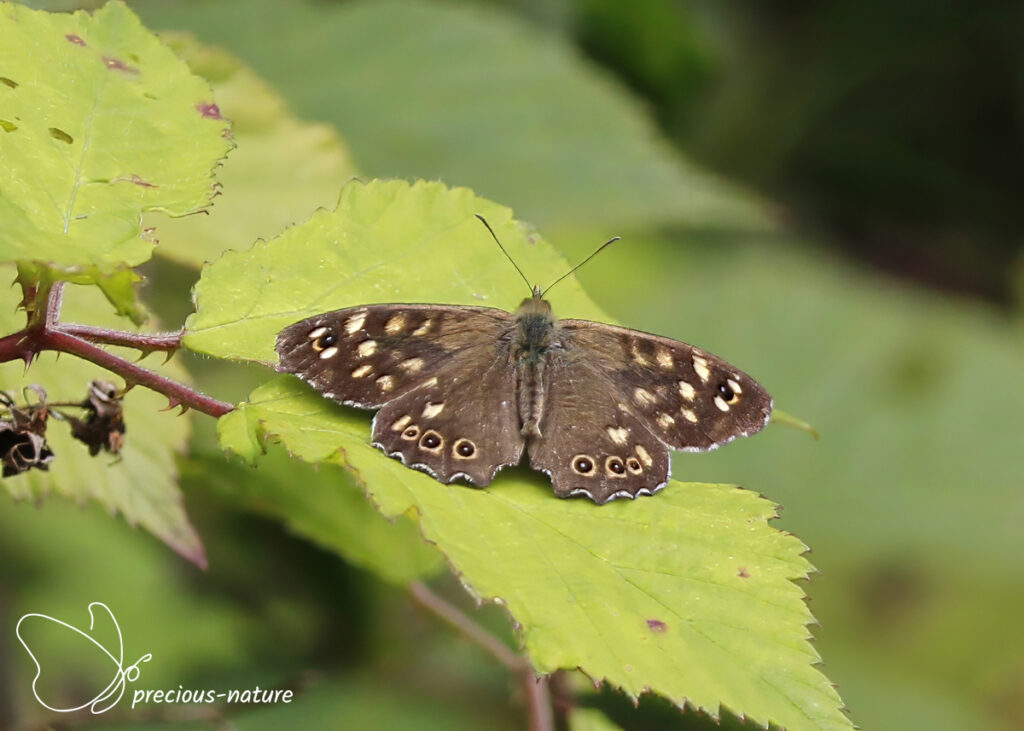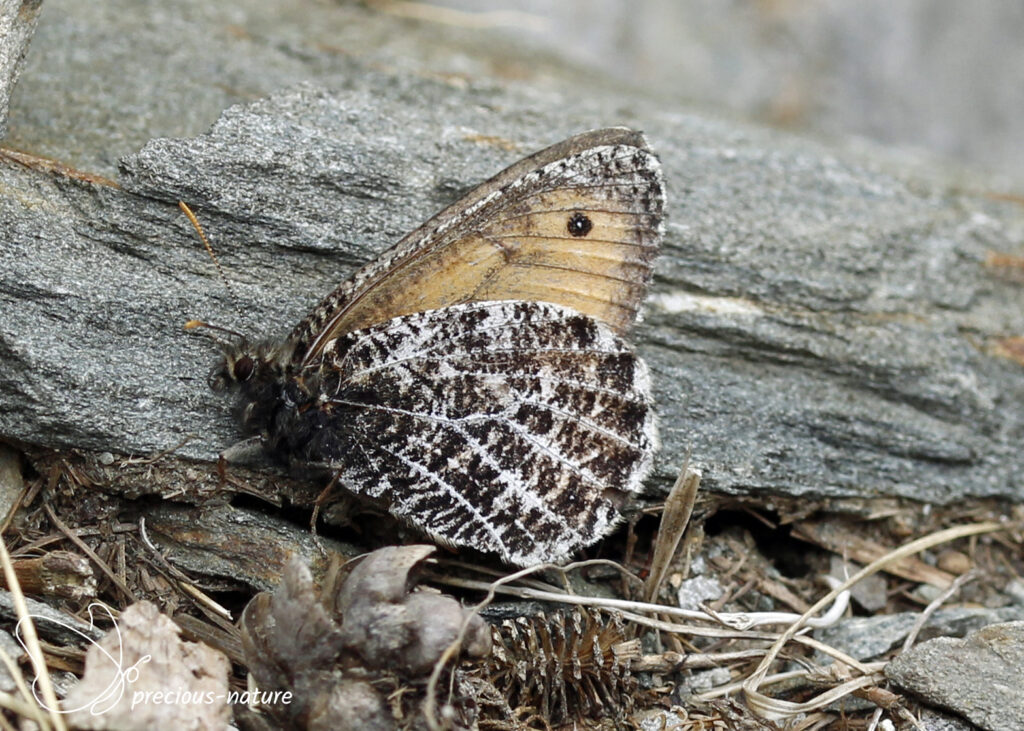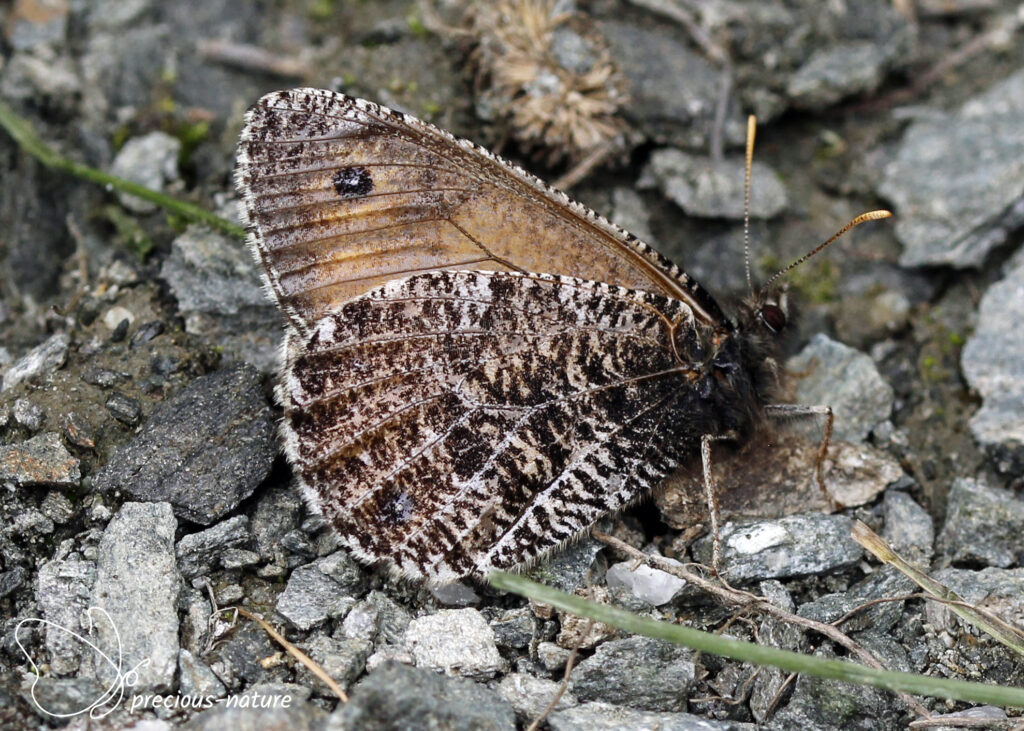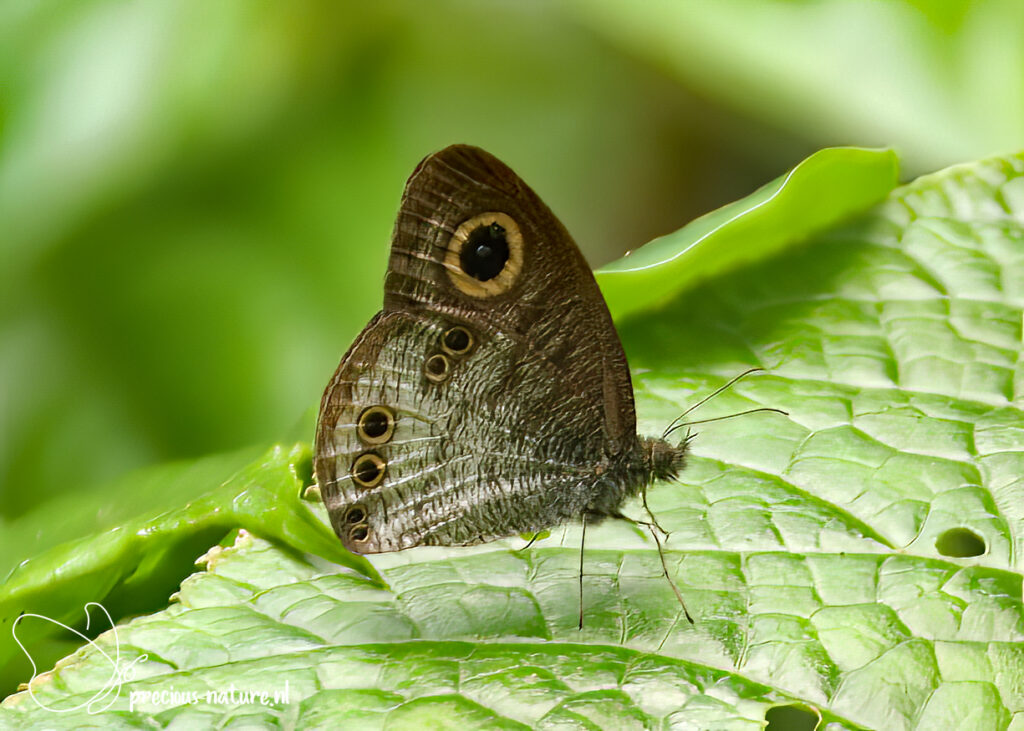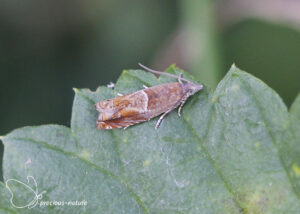The Satyrs and Wood-nymphs (Satyrinae), the biggest subfamily of the Brush-footed butterflies (Nymphalidae), are generally inconspicuous and brown. This is probably why there is a lack of interest in this subfamily. Compared to other species, the colour gives them a dull look. At the underside of the wings, they have circular eyespots to which they owe their family name. The host plant is typically a species belonging to the grass family. It is not always easy to identify the Satyrs and Wood-nymphs.
Tribe: Erebiini
Genus: Erebia
Almond-eyed Ringlet – 2024 (CH)
(NCBI-index: 2.599362)
The ringlets fly mainly in the mountains. I have travelled to Switzerland and walked over alpine meadows for all these butterflies. The identification requires attention, and data on altitude and habitat are helpful in this regard. The Almond-eyed Ringlet (Erebia alberganus) was the first ringlet I had seen. It flies in areas with warm, flowery grasslands facing south and often in the shelter of forest at altitudes of 1000 – 2200 m. The upper and underside of the wings are almost the same, whereby an orange spot pattern on the brown ground colour can provide the identification. The ground colour on the wings’ underside is slightly lighter. The orange or reddish spots in the edge area are oval and pointed with a small brown marking (male) or a small brown marking with a white spot (female). The flight period is from June to August in one generation, and the wingspan is 38 to 40 mm. Host plant: Sheep’s Fescue and Common Vernal Grass. Dutch name: Amandeloogerebia. Frisian name: –
Flying period:

Tribe: Erebiini
Genus: Erebia
Large Ringlet – 2024 (CH)
(NCBI-index: 111902)
The Large Ringlet (Erebia euryale) exhibits a distinct appearance that varies depending on its geographical location. Usually, the upper side of the forewings is dark brown with a reddish-orange band along the trailing edge that consists of loose spots. Three or four orange spots contain oval black dots, with a white core in the females, often without or reduced to small dots in the males. All wings show chequered fringes. The forewings of the males show no scent stripe. The upperside of each hindwing usually has three eyespots surrounded by orange. The underside of the females’ hindwings shows a diffuse, clear, or whitish or yellowish band, which is strongly serrated and conspicuous. The flight period spans one generation, from late July to August, and the wingspan measures 20-23 mm. Host plant: Blue Grass, Needled Sheep’s Fescue, Red Fescue, Alpine Fescue. Dutch name: Grote erebia. Frisian name: –
Flying period:

Tribe: Erebiini
Genus: Erebia
Prunner’s Ringlet – 2024 (CH)
(NCBI-index: 242256)
The Prunner’s Ringlet (Erebia triaria) lives on rocky grasslands, steep meadows with rocks and open ground and other dry mountain slopes of the Southern Alps, from about 500 m to 2200 m above sea level. Like its relatives, the Prunner’s Ringlet has brown wings with orange spots along the trailing edge. The main distinguishing features are the early flight time and the eyespots near the wingtip on the forewing, which are always in a straight line. The underside of the hindwing is finely stippled, giving it a rough appearance. It resembles the Piedmont Ringlet (Erebia meolans), which flies later in the year and in which the eyespots, if present, are not in line. The postdiscal band on the underside of the forewing is red in the male. The flight period is from April to mid-July in one generation, and the wingspan is 40-45 mm. Host plant: Sheep’s Fescue, Various-leaved Fescue. Dutch name: Zuidelijke erebia. Frisian name: –
Flying period:

Tribe: Erebiini
Genus: Erebia
Mnestras Ringlet – 2024 (CH)
(NCBI-index: 468186)
The upperside of the Mnestras Ringlet (Erebia mnestra) has a large orange band, which in the male is serrated on the outer edge and usually does not contain an eyespot. At least, that is the theory. Small spots, usually without eyespots, can be present on both wings. The underside of the forewing is conspicuously orange and (usually) again lacks eyespots. The underside of the hindwing is uniform and does not show strong markings in the male, although the shadow of a postdiscal band may be visible. Only the female has conspicuous markings: two eyespots in the orange band on the upperside of the forewing and a hint of a grey band on the underside of the hindwing. The flight period spans one generation, from early July to mid-August, and the wingspan ranges from 34 to 38 mm. Host plant: Fescue, Blue Grass. Dutch name: Alpenzijde-erebia. Frisian name: –
Flying period:

Tribe: Satyrini
Subtribe: Coenonymphina
Genus: Coenonympha
Small Heath – 2015 (NL)
(NCBI-index: 242262)
The Small Heath (Coenonympha pamphilus) is a common butterfly that flies around for two or three generations from March to October. It is an unnoted butterfly that flies only in sunshine and rarely settles more than a meter above the ground. The habitat is found on grasslands with fine grasses, especially in dry, well-drained areas where the grasses are short and sparse. The underside of the hindwing usually has small brown-rimmed white dots. The top is light orange-brown. The wingspan is 34-38 mm. Host plant: bents, fescues, and meadow grasses. Dutch name: Hooibeestje. Frisian name: Heaflinter.
Flying period:

Tribe: Satyrini
Subtribe: Coenonymphina
Genus: Coenonympha
Common Heath – 2018 (NL)
(NCBI-index: 132697)
A critically endangered and rare butterfly is the Common Heath (Coenonympha tullia). This species is slowly returning to the Fochtelooerveen (Netherlands) due to remedial measures taken. This habitat consists of wet, boggy areas. The top of the wings is brown with a small black eye spot at the apex of the forewing. The underside of the forewing is orange at the base, which changes from a white blotch into light brown. The underside of the hindwing is brown. On both wings is a row of black eye spots at the outer edge with a white core and a yellow border around it. The characteristic is the white blotch on the outer edge of the hindwing that runs up to the wing edge. The wingspan is 41 mm. Adults always sit with their wings closed and fly even in dull weather. The flight period spans from June to August, encompassing one generation. Host plant: Hare ‘s-tail Cottongrass. Dutch name: Veenhooibeestje. Frisian name: Feanheaflinter.
Flying period:

Tribe: Satyrini
Subtribe: Coenonymphina
Genus: Coenonympha
Pearly Heath – 2023 (DE)
(NCBI-index: 111894)
The top of the forewing of the Pearly Heath (Coenonympha arcania) is orange with a dark brown border, and the top of the hindwing is brown. You hardly see this one because it almost always sits with its wings closed like its peers. On the hindwing’s underside is a row of eyespots and a single brown-ringed eyespot. There is a silvery stripe on the outside of the row of eyespots, and the inside is a wide white field that is longer than the row of spots. The male is slightly smaller and has shorter and more pointed wings than the female. The white field and the row of eyespots are distinctive for identification concerning the Alpine Heath (Coenonympha gardetta) and the Scarce Heath (Coenonympha hero). In the Alpine Heath, the eyespots are not double-rimmed and lie in the white field, and in the Scarce Heath, the white field is much narrower. The flight period spans one generation, from late May to August, and the wingspan ranges from 28 to 38 mm. Host plant: various types of grass, including Sheep Grass and Meadow Grass. Dutch name: Tweekleurig hooibeestje. Frisian name: Twakleurheaflinter.
Flying period:

Tribe: Satyrini
Subtribe: Coenonymphina
Genus: Coenonympha
Darwin’s Heath – 2024 (CH)
(NCBI-index: 2.566450)
To discover the Darwin’s Heath (Coenonympha gardetta darwiniana) you have to travel specifically to the Alps. This brown-winged butterfly is difficult to identify due to its similarity to the Alpine Heath (Coenonympha gardetta) and the Pearly Heath (Coenonympha arcania), and the variation within the species. The interbreeding between Darwin’s Heath and Alpine Heath makes it even more difficult. On the underside of the hindwing, all three species can see a white band with black eye spots. In Darwin’s Heath and Pearly Heath, there is a yellow border around the black eye spots, which is absent in the Alpine Heath. In addition, the eyespots in Alpine Heath are located in the white band, whereas in the other two species, they are positioned on the outside. Darwin’s Heath has a narrower and equal-width white band, while in the Pearly Heath, it is broader and more irregularly shaped. The underside and upperside of the forewing are orange with a dark brown edge. On the underside of the forewing, you see along the leading edge a light grey-brown stripe that becomes wider in the wingtip. On the wingtip, there is a black dot with a light band. The flight period spans one generation, from June to August, and the wingspan ranges from 28 to 38 mm. Host plant: various grasses. Dutch name: Darwin’s hooibeestje. Frisian name: Darwin’s heaflinter
Flying period:

Tribe: Satyrini
Subtribe: Coenonymphina
Genus: Coenonympha
Alpine Heath – 2024 (CH)
(NCBI-index: 554481)
Like Darwin’s Heath (Coenonympha gardetta darwiniana), the Alpine Heath (Coenonympha gardetta) also flies in the Alpine region at higher altitudes. Both species are also difficult to distinguish from each other. The upperside of the butterfly is predominantly grey-brown, and on the forewing, a more orange-coloured field can often be distinguished. The underside of the hindwing is dark grey-brown, with a white zone with eye spots. The distinguishing feature is the eye spots, all enclosed by the white zone. A second feature distinguishing the Alpine Heath from Darwin’s Heath is the grey broad band along the rear edge on the underside of the forewing. In Darwin’s Heath, this grey colour can only be seen in the wing tip. The flight period depends on the altitude of one generation from the end of June to mid-September, and the wingspan is 35-40 mm. Host plant: Fescue and Meadow Grass. Dutch name: Alpenhooibeestje. Frisian name: –
Flying period:

Tribe: Satyrini
Subtribe: Euptychiinae
Genus: Taygetis
Stub-tailed Satyr – 2024 (MX)
(NCBI-index: 270093)
After a tour near Valladolid, Mexico, I returned to the hotel, and there was the Stump-tailed Satyr (Taygetis virgilia) sitting with its wings closed in the glow of an outdoor lamp. This sand eye occurs from Mexico to Honduras, Colombia, Suriname and Guyana. The identification of this species is based on the markings on the underside of the fore and hind wings. Halfway between the front and rear wings, you will see a dark brown transverse stripe with a yellow-white line on the outside. Near the wing root, you can see a faint brown line that is slightly curved. A faint brown transverse line can also be seen on the forewing, and further towards the other transverse line is a black dot. Furthermore, a row of white dots can be seen in the zoom field. The underside and top of both wings are further brown, and the trailing edge of the hindwing is strongly serrated. In males, the area near the trailing edge of the hindwing is orange-brown. The wingspan is approximately 68 mm, and the flight period is unknown. Host plant: Bamboo. Dutch name: Stopmpstaartzandoogje. Frisian name: –
Flying period:
Unknown
Tribe: Satyrini
Subtribe: Maniolina
Genus: Maniola
Meadow Brown – 2008 (FR)
(NCBI-index: 191418)
The Meadow Brown (Maniola jurtina) is often mistaken for a Small Heath if the butterfly’s wings are closed. A significant difference is that the Meadow Brown does not have small white dots on the underside of the hindwing. The difference is visible as soon as the Meadow Brown spreads its wings. In the male, the top of the forewing is brown with a black eye-spot without a white core; in the female, on the other hand, an orange field and a black eye-spot with a white core can be seen. Sometimes, a double white core like the Gatekeeper (Manolia tithonus) could occur. The top of the hindwing is brown on both species. The Meadow Brown is the most abundant butterfly species in many habitats. Adults fly even in dull weather when most other butterflies are inactive. The flying period spans one generation, from early June to August, and the wingspan measures 50-55 mm. Host plant: fescues, bents, meadow grasses, Cock’s-foot, False Brome. Dutch name: Bruin zandoogje. Frisian name: Brún sâneachje.
Flying period:

Tribe: Satyrini
Subtribe: Maniolina
Genus: Maniola
Subgenus: Aphantopus
Ringlet – 2016 (NL)
(NCBI-index: 2.795564)
A new Ringlet (Maniola hyperantus) has a velvety appearance and is almost black on top of both wings, with white fringes. The underside is light brown and has distinctive yellow-rimmed black eyespots with a white core. The small circles on the hindwing, which give the butterfly its name, vary in number and size and could be enlarged, elongated, or reduced to small white spots. The wingspan is 48-52mm. Bramble and Wild Privet flowers are nectar sources, and adults continue to fly with a characteristic bobbing flight in dull, cloudy conditions when most other butterflies are inactive. This common butterfly flies in one generation from June to August. Host plant: Cock’s-foot, False Brome, Tufted hair grass, Common Couch, meadow grasses. Dutch name: Koevinkje. Frisian name: Donker sâneachje.
Flying period:

Tribe: Satyrini
Subtribe: Maniolina
Genus: Maniola
Subgenus: Pyronia
Gatekeeper – 2008 (FR)
(NCBI-index: 2.795565)
The Gatekeeper or Hedge Brown (Manolia tithonus) can be distinguished from the Meadow Brown (Maniola jurtina) by the orange upper side with a broad brown edge on both the fore- and hindwings. A black eye with a double white core is visible at the apex of the forewing. This is not a characteristic that gives a definite answer because the female of the Meadow Brown sometimes also has a double white core. The wingspan is 40-47 mm. The Gatekeeper flies in one generation from July to September. As its name suggests, he is often encountered where clumps of flowers grow in gateways and along hedgerows and field edges. Favourite nectar sources include Wild Marjoram, Common Fleabane, ragworts, and Bramble. Host plant: bents, fescues, meadow grasses, and Common Couch. Dutch name: Oranje zandoogje. Frisian name: Oranje sâneachje.
Flying period:

Tribe: Satyrini
Subtribe: Melanargiina
Genus: Melanargia
Marbled White – 2022 (DE)
(NCBI-index: 111923)
During a visit to the “1000-butterfly valley” in the Eifel region in Germany, I came across the Marbled White (Melanargia galathea), a butterfly you do not encounter in the north of the Netherlands. You would rather expect this butterfly in the family of the Whites and Sulfurs because of its colour, but it is still counted among the Satyrs and Wood-nymphs. Both the under and top of the wings are white, with many black areas on the top of the wings along the edges and at the base. There are also black areas on the underside of the wings, while those on the rear wing are more light grey. The female can often be recognised by the light brown spots on the bottom, mainly light yellow. The male and female have several eyespots on the underside of the wings. The flight period spans one generation, from mid-June to August, and the wingspan measures 55 mm. Host plant: Red Fescue, Sheep’s Fescue, Tor-grass, Cock’s-foot. Dutch name: Dambordje. Frisian name: –
Flying period:

Stam: Satyrini
Subtribe: Mycalesina
Genus: Orsotriaena
Dark Grass-brown – 2022 (INA)
(NCBI-index: 366129)
When I travel, I always look for new butterflies. In Bali, near the hotel, a very agile butterfly flew, and I had trouble getting a picture of it. Ultimately, you must be happy with what you can make of it before it disappears. The Dark Grass-brown (Orsotriaena medus) is just as agile as its congeners and as challenging to photograph at certain times. The tops of the wings are dark brown with a thin marginal pale edge. There are no eye spots on the top of the wings, which is the case on the underside of both the front and rear wings. There are five eye spots on the underside of the wings. In the forewing, there are two eye spots, with the anterior eye spot being slightly smaller. In the rear wing, you can see two eye spots near the wing tip and a separate eye spot near the inner edge corner. A white band runs along the eyespots on both the hind and rear wings. The butterfly basks in the sun, often with its body parallel to the sun’s rays. The wingspan is 45-55 mm. Host plant: grasses. Dutch name: Donker grasbruintje. Frisian name: –
Tribe: Satyrini
Subtribe: Parargina
Genus: Lasiommata
Wall Brown – 2015 (NL)
(NCBI-index: 111917)
The Wall Brown (Lasiommata megera) is a butterfly that has been around the Netherlands from March to October for several generations. It is similar in size and colour to the Gatekeeper (Manolia tithonus), but the Wall Brown is much more heavily patterned and sometimes confused with small fritillary butterflies. The Wall Brown is aptly named after its habit of basking on walls, rocks, and stony places. The delicately patterned light brown undersides provide good camouflage against a stony and sandy surface. In hot weather, males patrol fast and low over the ground, seeking females. In cooler weather, they will bask in sunny spots and fly up to intercept females or to drive off other males. The fore and hindwings are orange at the top with brown veins and hem stripes. A black dot with a white core on both wingtips of the forewing. The male is distinguished from the female by the hairy scent stripe on the upper side of the forewing. The wingspan is 44-46 mm. Host plant: False Brome, Cock’s-foot, bents, Wavy Hair-grass. Dutch name: Argusvlinder. Frisian name: Argusflinter.
Flying period:

Tribe: Satyrini
Subtribe: Parargina
Genus: Lasiommata
Large Wall Brown – 2024 (CH)
(NCBI-index: 111916)
Large Wall Brown (Lasiommata megera) is a butterfly related to the Wall Brown (Lasiommata maera). The underside of the forewing and hindwing is almost the same, except that the Large Wall Brown has a black spot with two white dots in the wingtip, while the Wall Brown has only one white dot. The upper side is indeed different. The upper side of both wings is brown with only a few orange spots. On the forewing, there is a black spot with two small white spots, and on the hindwing, along the rear edge, you see two black round spots with a white core. The species prefers rocks to warm up, but also likes to fly along forest edges with rough, flowery grassland. The flight period spans one generation, from June to August, and the wingspan ranges from 44 to 56 mm. Host plant: Cocksfoot, Fescue, Sweet Grass, Meadow Grass. Dutch name: Rotsvlinder. Frisian name: –
Flying period:

Tribe: Satyrini
Subtribe: Parargina
Genus: Lasiommata
Northern Wall Brown – 2024 (CH)
(NCBI-index: 111918)
The Northern Wall Brown (Lasiommata petropolitana) is easily confused with theLarge Wall Brown (Lasiommata maera). The upperside of the forewing is brown with a black spot at the top. On the upperside of the hindwing, a transition is visible between the lighter postdiscal zone and the darker discal and basal zone. In the Large Wall Brown, there is no such transition. The hindwing is brown with a series of black spots. In addition, there is a series of spots on the underside of the hindwing. The spots in zones S2, S3 and S6 are slightly larger. The flight period spans one generation, from late April to early August, and the wingspan ranges from 34 to 42 mm. Host plant: Bushgrass, Sheep’s Fescue, Red Fescue. Dutch name: Kleine rotsvlinder. Frisian name: –
Flying period:

Tribe: Satyrini
Subtribe: Parargina
Genus: Pararge
Speckled Wood – 2018 (NL)
(NCBI-index: 116150)
The Speckled Wood (Pararge aegeria) is easily identifiable. The top of the wing is dark brown with many yellow spots, larger in the female than in the male. The yellow spots close to the dorsum have black spots with a small white core, and on both wingtips of the forewings. The wingspan is 47-50 mm. The butterflies often perch in sunny places, spiralling into the air to chase each other to intercept an intruder. Both sexes feed on honeydew in the treetops and are rarely seen feeding on flowers except early and late in the year when aphid activity is low. This satyr flies around in several generations from February to November. Host plant: False Brome, Cock’s-foot, Common Couch. Dutch name: Bont zandoogje. Frisian name: Bûnt sâneachje.
Flying period:

Tribe: Satyrini
Subtribe: Satyrina
Genus: Oeneis
Alpine Grayling – 2024 (CH)
(NCBI-index: 988006)
The Alpine Grayling (Oeneis glacialis) is a butterfly specific to the Alps. This species flies along scree slopes, boulders and rocky or stony grasslands or meadows at about 1700 m to at least 2700 m above sea level. Adults are often found on rocks along riverbanks. They are challenging to spot because of their camouflage, and as soon as you get too close, they fly away, and the search starts again. Although the underside of the forewing is orange with a black spot and a white core in the wingtip, this is positioned behind the crackled brown-white hindwing in the resting position, and they are almost invisible when they sit on a rock. The conspicuous white veins are characteristic of this species. The upperside of both wings is mainly light brown with a pale orange band in the margin, and on both the forewing and hindwing, there are two black spots with a white core. The flight period spans one generation, from early June to mid-August, and the wingspan ranges from 50 to 56 mm. Host plant: Fescue and Ryegrass. Dutch name: Gletsjervlinder. Frisian name: –
Flying period:

Tribe: Ypthimini
Genus: Ypthima
Common Five-ring – 2022 (INA)
(NCBI-index: 270470)
The Common Five-ring (Ypthima baldus) is a tropical butterfly marked with fine stripes on the underside of the wings and has a series of submarginal yellow-ringed black eyespots. A very large eyespot with two small white dots is on the underside of the forewing near the tip of the wing. Where the fine stripes on the underside are still uniformly distributed, they differ on the wings’ top. Along the wing margins, a lighter zone can be seen where the eyespots are located. This species is found in grassy forest margins and secondary growth at elevations between 300 and 1200 meters. Both sexes prefer to fly in cloudy weather and are not averse to flying in light rain. They can be found basking on leaf litter or little grass, but are quite nervous in behaviour. The wingspan is 30-40 mm. Host Plant: Wide-leaved Carpet Grass, Cow Grass. Dutch name: Gewone vijf-ring. Frisian name: –

